.
COUNTY FACILITIES COMMITTEE MINUTES – FEBRUARY 14, 2018
DEBRA J. CODY, VICE CHAIR
MEMBERS PRESENT: Mr. Holmquist, Mr. Knapp, Mrs. Ervin
MEMBERS ABSENT: Chair Tassone
ALSO ATTENDING: Chairman McMahon, Mr. Rowley, Mr. Buckel, Mr. McBride, Mr. Bush, Mr. Jordan; see attached list
Vice Chair Cody called the meeting to order at 10:30 a.m. A motion was made by Mr. Knapp, seconded by Mrs. Ervin to waive the reading of the minutes of the previous committee meeting; MOTION CARRIED. A motion was made by Mr. Knapp, seconded by Mr. Holmquist to approve the minutes of the previous committee meeting; MOTION CARRIED.
1. ONONDAGA COUNTY PUBLIC LIBRARY: Steve Morgan, Chief Fiscal Officer
a. Amending the 2018 County Budget to Make Funds Available in Connection with the Central Library Reconfiguration Project ($2,355,520)
Mr. Morgan:
-
Resolution tabled last week; dollar amount changed from $4.3 mil to purchase price of sq. ft. library occupies
-
$2.3 mil to purchase 28K sq. ft. already occupied; part of renovations on 1st, 2nd and 3rd floor
-
Space leasing is basement, 1st and 2nd floors; 3rd floor always owned; Basement, 1st, 2nd and 3rd floors are library operations; 4th and 5th County owns and leases to SUNY Upstate
-
Desire to update library and space to fit operations; more presence on lower level and entrance off Salina St.
-
Renovate and try to identify revenue stream to pay for some of work, and leasing on 4th and 5th floors to external party
-
Vacated 4th and 5th; SUNY Upstate now rents; renovated 1st, 2nd & 3rd floors where library is now
-
Basement, 1st, 2nd and 3rd floor is in total about 80,000 sq. ft.; own about 52,000 sq. ft., the delta is additional sq. ft. asking to purchase; 4th and 5th is about 30,000 sq. ft. each - currently leased to SUNY Upstate
-
Project set up to take lease payments from SUNY, and pay rent payments from space leasing from Galleries, as well as condo charge for SUNY Upstate space, and lastly maintenance and repairs to SUNY space
-
Buying sq. ft. allows discontinuation of paying rent - saves money in long term; continue to use project to operate 4 & 5
Mr. Knapp asked what is in the basement, and the third floor. Mr. Morgan responded:
Mr. Morgan:
- Desire to reconfigure space to be conducive to programming
-
Oct 11th (2011) – $5.2 mil bond resolution for assistance in renovation and reconfiguration; passed
-
Nov. 14th
- Local Law No. 12-2014 – gave County Executive authority to enter lease with Galleries for 4 and 5; ~60,000 sq. ft.
- Local Law No. 13-2014 – authorized lease with galleries for ~29,000 sq. ft.; included option to purchase at $2.3 mil
- Res. No 176-2014 – budget resolution approved at $6.5 mil
Project revenue stream from lease to SUNY Upstate on 4 and 5; expenses include: condo charge on 4 and 5, maintenance and upkeep on 4 and 5, and rent to galleries for 28,000 sq. ft. on 1 and 2
-
July 2015 – County entered into 10 year lease of 60,000 sq. ft. that ends in Sept. 2026; same month entered lease with galleries; authorized County to lease 29,000 sq. ft. and purchase option of $2.3 mil
-
Language in lease says anywhere after November and no later than December 2019
-
Desire is to purchase property as opposed to renting; long term saves money; spent $5.2 mil to renovate; to continue to rent space the County renovated from landlord makes little sense
-
Library will be there long time; no sense to continue to lease, and lease requires County to buy by the end of next year
- Can spend 2 more years paying rent, and buy for same price; or buy now, and save paying rent
Mr. Holmquist stated the job of the Legislature for this issue is to focus on the finances. Is there a recent appraisal? Mr. Morgan said no; the purchase price was decided upon in the local law and lease. There was no need for an appraisal.
Mr. Holmquist said there should be an analysis of buying or leasing. What analysis was done to come to the conclusion that it makes sense to buy? Mr. Holmquist asked for an analysis that Mr. Morgan could provide the Legislature. Mr. Morgan replied:
- Basic analysis - County pays rent for full term of lease or buys it; can figure time value of money
- People throwing out 3%, but if someone gets 3% on their money, it’s wrong line of business
- County is not getting 3% on the money; basic delta between lease payments vs. purchase price – close to $3 mil
Chairman McMahon commented:
Mr. Morgan cannot speak to the process used back in 2014. Mr. Durr stated the County is in a unique position, because part of the building is already owned versus buying a separate piece of property. Mr. Durr assumes a lot of this was done based on the square footage of the rental value. The rental value is different than the possible appraised value. Chairman McMahon has been in real estate, and is comfortable with the number; although some colleagues are not. It would not take a lot of work to get a quick cost approach. The concern is the value of the property at $2.3 mil.
Mr. Holmquist was expecting detail on the cost per square foot, and some type of analysis on how they came up with the purchase price. Mr. Morgan stated the purchase price was agreed to in the local law, and the lease. Mr. Morgan does not know the value of it now. Mr. Durr commented that this was decided in 2014, so this should have been vetted at that time. That was when the original purchase price was approved in legislation. Chairman McMahon stated the issue is not the $2.35 mil. Even if everyone agreed on what the documentation says, the Legislature is being asked to execute at a date earlier than they have to. It is not hard to have a commercial real estate agent pull some comparables; especially with the improved space and the money spent to renovate. It is probably worth double. If this is the concern, it is not a hard ask. Mr. Durr commented that they run the risk of the landlord demanding payment of rent. Chairman McMahon responded that he has been contacted by the owner already, and is just offering friendly advice.
Mr. Holmquist asked what the County is paying per square foot. Mr. Morgan said $2.35 mil divided by 28,000. Mrs. Venditti said $8 per square foot. Mr. Rowley said that is the lease; the County is paying $82 and change. Mr. Holmquist asked what the going rate is. Mr. Morgan said if they want to debate the legality of the lease, then they can do that. The price is the price. It was determined back in 2014, and asked if these questions were asked back then. Chairman McMahon interjected that there was methodology, and explained that what is paid in a lease is not the same as purchasing (pay more for purchase). Mr. Holmquist said that’s why his first question was where is the analysis of the two options including the time value of money, so the Legislature can look at the numbers. Mr. Holmquist fully expected a basic analysis to be able to delineate what the true costs are both long term and short term with both options. This would give an idea of what the going rate is in the area, and if the County is getting a good deal. Mr. Morgan wondered if it was a good idea back when the Legislature forwarded it in 2014. Mr. Morgan questioned if Mr. Holmquist approved the local law for a specific dollar amount, and Mr. Holmquist said yes.
Mr. Holmquist wanted to know what the job of the County Legislature is on this issue. Does the Legislature just accept everything Mr. Morgan is saying without any backup? Mr. Morgan replied that they did back in 2014. The local law approved the purchase price. What was the basis for the approval back then, and why is it different now? Mr. Holmquist would gladly talk about the history, but does not feel this is the right forum. Vice Chair Cody agreed, and said the committee is considering where they are now, and how they are moving.
Mr. Holmquist:
Mr. Morgan responded that the simple answer is no. There used to be a representative from the Legislature on the Condominium Board until Kathy Rapp retired. Mr. Morgan replaced Kathy Rapp on the board; along with Bill Fisher. There’s been no change on the condominium charge. The only change will be when, and if, the County owns the additional space; at which time the condominium charge goes up $35,000 per year. It will be a cost to the library for that space. Mr. Holmquist asked what the County gets for that. Mr. Morgan explained it includes the AC systems, the HVAC system, the mechanicals and building systems. Mr. Holmquist requested an analysis of the benefits the County is getting for that price (condominium charge). Mr. Morgan inquired about what type of analysis Mr. Holmquist is asking for as he just stated what the services are. Mr. Holmquist would like the services and costs. Chairman McMahon said to put it in writing.
Chairman McMahon:
- The owner has 4 (condominium) board picks and 2 for other units
- Is there anything to state representation from the Legislature?
- Is there anything that says the Legislature could pick Steve (Morgan) if they wanted?
- Why did this not come back to the Legislature?
- Is there anything that says the County Executive has both picks?
Mr. Morgan sent the bylaws over for the condominium yesterday. Chairman McMahon is interested in this as a side note. Is it in writing? Mr. Durr commented that there is always legal recourse when condominium fees are thought to be unfairly portioned. The relationship has been good, and can renegotiate. Based on past practices the condominium board has been fair to all the owners.
Chairman McMahon is more concerned with representation. Mr. Knapp and Vice Chair Cody agreed.
Mr. Holmquist asked why there is no purchase agreement, because if there was, all these issues would have been vetted out. Mr. Durr replied that there is no purchase agreement, because it was documented in the lease; which is a contractual document. It is not unusual to have a lease with the option to buy, which is what this is. There would not be a purchase agreement. Chairman McMahon said it’s safe to assume there are closing documents that were prepared. Mr. Durr said that and an abstract. Chairman McMahon said those would probably be in trade of a purchasing agreement. Chairman McMahon requested copies (of all closing documents) be sent the Legislature. Mr. Durr responded that he can send them.
Mr. Holmquist wanted clarification that the various items requested in writing be provided to the Ways and Means members soon, so they have a few days to review it. Most of the information was given to Mr. Holmquist yesterday. Mr. Morgan commented it was asked for yesterday. Mr. Holmquist said they should not have to ask, and Mr. Morgan should be well prepared way in advance.
Vice Chair Cody said the documents requested today will be provided to Ways and Means. If this is passed today in committee, it will go on to Ways and Means.
Vice Chair Cody stated that Mr. May wanted to apologize for not being here, as he wanted to be here today.
Mr. Morgan said that any documents requested by Sue (Stanczyk) were provided. If there are new questions that the committee was expecting to have at their fingertips, then Mr. Morgan did not know that. Any specific information requested, they will work on getting (to the Legislature). Mr. Holmquist said the Ways and Means committee members would appreciate the information days in advance to review it, and come up with questions.
Mr. Knapp asked Mr. Morgan to expand on the time value of money, what the County is getting, and what the County can invest in if they did not spend it now. Mr. Morgan responded there are varying rates of return on investments. The average is anywhere between 0.2% and 0.5%. Are there investments that garner a higher rate of return? Yes, but the money has to be locked up for 10 plus years. The County has to have the ability to stay liquid, especially with where cash flow is now. Mr. Morgan said they look to maximize return on pool cash, so there is cash on hand to pay bills. The County does not lock up money for any length of time.
Mrs. Ervin wanted to clarify that Mr. Morgan would be providing copies of the closing documents, and something that shows the difference in costs of buying now versus later. Mr. Morgan agreed. Mr. Knapp added the time value analysis.
Mr. Holmquist asked what the benefit is to the County to own the floors that are leased to SUNY Upstate. Why should the County own those floors? Mr. Morgan answered that the County owns them now, unless someone wants to buy them. There’s no option except owning. Mr. Holmquist asked what the benefit is. Mr. Morgan replied it provides rent to allow the County to pay for the costs of owning 4 and 5, as well as paying for the purchase price of the square footage being considered now. By leveraging the rent from SUNY, the County can pay for: the maintenance on 4 and 5, the $2.3 mil for the square footage, and the outfit for 4 and 5 if SUNY does not take the space. Mr. Holmquist requested it be delineated in numbers, so the Legislature can see what the numbers are. Mr. Morgan said okay.
Mr. Knapp asked if there is a purchase option in the lease with SUNY Upstate, and Mr. Morgan said he is not aware of one. Mr. Durr does not think so. Mr. Knapp asked if there is any interest, and Mr. Durr replied no; but there are two 5 year extensions. As a property owner, the more interest one has in the property, the more control there is. If they sever the interest, then they lose leverage.
Mr. Rowley stated the bond resolution in 2011 was for $5.2 mil, and to his understanding it was paired with a grant for $2.6 mil. Is this correct on what was received for the grant and spent on the properties? Mr. Morgan stated it was $2.5 mil. $2 mil went to this work, and $500,000 went to the owner of the Galleries. That was a condition in improving the space, and keeping employment downtown. Mr. Rowley said at this point it’s a little over $7 mil. In the current grant project, the County has spent $5.9 mil, and asked how much of that was spent on renovations. Mr. Morgan replied that some of it is rent, some condo charges, and some maintenance. The rest is renovations, which is probably over $5 mil. Mr. Rowley said in total it’s been about $12 - $13 mil. Mr. Morgan clarified that the $7 mil is for 1, 2, and 3. The project is only funding 4 and 5. The only expense related to the lease space of the library is rent. The project was set up to pay for the renovation of 4 and 5, as well as the condominium charge for 4 and 5, and maintenance. Mr. Morgan replied to Mr. Rowley that the only exception is the rent for the 28,000 sq. ft., but if this happens, then there is no more library related to the project.
Mr. Rowley:
- Did simple analysis; big difference between being a landlord and being a tenant
- Opinion - County has spent millions in commercial real estate business; extra costs for being in commercial real estate
- Has to be part of the analysis, or it is not a true analysis
- Extra costs are unknown, but Mr. Fisher said in neighborhood of $2 - $5 per foot; proposed a number of $2 mil
- Should take all costs (debt, insurance, common charge and utilities) and do an analysis of what it costs to be in the real estate business
- Not sure if there’s a better way to account for it, or requirement to account for it differently for a municipality
- Budget:
- Started project with $6.6 mil in appropriations
- County Executive wants another $4.3 mil in appropriations
- Totals $10.9 mil in appropriations
- Lease revenue from Upstate for 10 years locked in totaling $6.8 mil
- Looking at project, the County is under water for $4.1 mil
- Mr. Fisher’s number of the lease buyout is $2.9 mil
- Net against total, then still under water $1.2 mil
Chairman McMahon said Mr. Rowley has to take out the $2 mil, because it is not on the table.
Mr. Rowley continued:
Chairman McMahon:
- County is in library business, and owns 4th and 5th floor
- Project proposed by Library Board, trustees, and Executive, plus policy decision by Legislature
- To be in library business, it made more sense to have ground level space
-
Library costs money; almost everything done in government is not a breakeven; no breakeven to run the Legislative branch of government, Comptroller’s office, Executive’s office, etc.
- Do not expect this to be a profit center
Mr. Buckel:
- First reaction was to look at the details of the transaction; Legislature being told they have no choice
-
If developer with document as signed said they will hold the County to this commitment, then it could be enforced
-
Has happened this way, so Legislature should scrutinize deal carefully
-
“How much is it going to cost to own?” “Are we paying too much?” legitimate questions; should have option or choice
-
There were appraisals done at same time deal was negotiated, because the Galleries disputed their tax assessment; both Galleries and the City did assessments; Legislature should get those; need to look at the price
-
$83 per sq. ft. may be the 1st or 2nd highest price ever paid for a piece of commercial real estate in Syracuse
-
Possibly the Lincoln Center sold for more, but (to Mr. Buckel’s knowledge) no other property ever sold for this much
- Handout passed to committee members
.
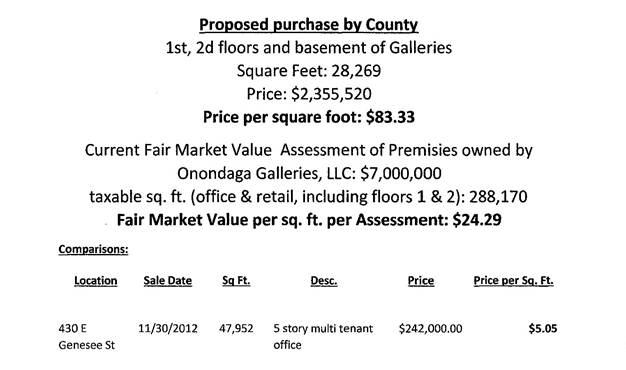
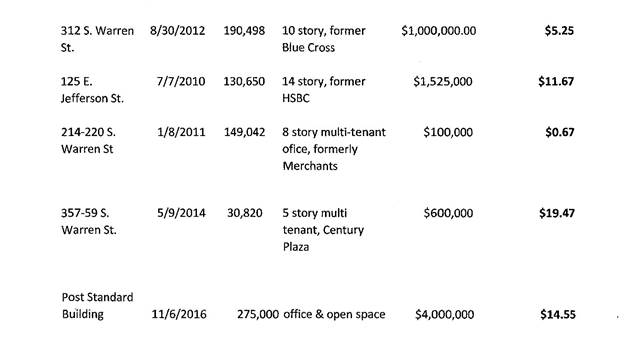
.
- Feel there is good reason to buy it; already own part of library space, so it makes sense to own the rest of it
-
Do not know if the government should be in the real estate business, but the County is
-
It also makes sense for the developer - library space, lease is below market and includes costs; willing to guarantee the owner will sell this
-
On record that the developer put a $7 mil mortgage on it in the fall; do not know if this includes the County’s portion or not, but need to find that out; Is the bank getting this money or the developer? Does not matter if the price is right
-
The question is the price; hoping the Executive side will back off; do not feel that is correct
-
Do not fully understand the analysis, but do understand appraisal by sq. ft.
- (i.e.) Post Standard building is open and office space, and it sold for $14 or $15 per sq. ft.
- $20 per sq. ft. is a high price; $83 is possibly the highest ever paid; Why? Would like to do the economics
Mr. Durr asked if Mr. Buckel is suggesting they renegotiate the price from 2014. Mr. Buckel does not want to just suggest. Mr. Buckel stated the promise and commitment of that lease, when matched against the authorization of this Legislature, is not enforceable. Mr. Durr disagrees. Mr. Buckel guarantees that Mr. Durr does not have a case, and asked Mr. Durr to show him. Mr. Buckel has litigated five cases like this, and two were against the County. It is the exact same situation, and the County won. There should not be a debate. The Legislature should be dealing with the matter and economics of whether it is a good deal or not. Mr. Buckel believes the County should buy it for the right price.
Mr. Jordan:
- Have done real estate for 30 years - investors; options to buy, leases, invested in real property, etc.
- Concept of option gives right to purchase property at some point in time based upon an agreed upon price
-
It’s an option, because one does not know if it’s a good deal or not; enter into option and negotiate price; often times pay certain sum of money to lock in the price
-
When making decision to exercise option, then go through analysis of whether it’s a good financial decision
-
Is the price agreed upon, a good price? Is it a good idea to exercise the option to buy at this price?
-
Question is not why the Legislature didn’t question the price when it was negotiated; the question is if it’s a good price now; does it make sense to exercise the option at the agreed upon price
-
All of the requests for information are extremely important; Legislature needs to make a good decision
-
Would like to see what was presented to the Legislature at that time in support of that price; tried finding minutes discussing the option to purchase and/or the purchase price, and cannot find anything anywhere
-
Hoping the Department of Finance or another department in the County has the information that was presented, because this information would illustrate where the price came from
-
Question is: “Is this the right price now?” “Is it to the financial benefit of the Legislature’s constituents to purchase this property at that price?”
-
As an owner of property, with all other potential liabilities assumed, one also assumes potential liability of a decrease in the value of that asset; it may not be a high likelihood, but it is a possibility
-
(i.e.) Renegotiated lease at Lincoln Center; problem in town with the glut of commercial space available; owners dying to find tenants; not unheard of for values to go down; a risk assuming by purchasing
-
Is the purchase price good, and is it a good idea to purchase the property? What is the long term goal of the library?
-
Downsized the library once, and if downsize again, then may end up with 20,000 – 30,000 sq. ft. of space the County may not need anymore; maybe should look into downsizing the library now
- All questions that need to be answered before jumping in to be a landlord or owner of commercial space
Mr. Morgan:
- Cannot tell what may happen 30 years from now; but can say the County has spent $5.2 mil to renovate space, and a good part of it, they do not own
- If the County runs out the term of lease, then looking at $184/sq. ft.; buying now, it is $83/sq. ft.
- Library just renovated, so will not change footprint; begs question “Why do that?”
Chairman McMahon commented that the marketability in the last 10 years has been good. The County brought in 400 new employees downtown. In the near term, it is very good, but the long term is like anything in real estate. Mr. Morgan said the building is one of the only ones that is fully occupied.
Vice Chair Cody stated there is a list of items requested to be provided to all Legislators in time for the Ways and Means committee. This will go to Ways and Means if the committee passes it today for them to review the documents and look at the financial issues. Mr. Holmquist said the issue has been considered here, and wanted clarification that it will go to Ways and Means either way; meaning the committee does not have to vote on this. Vice Chair Cody stated if the committee does not vote on this today, it will not go to Ways and Means. Mr. Holmquist said the committee has no financial information, so how can they pass it today. Mrs. Ervin commented that it can be discussed at Ways and Means. Vice Chair Cody agreed with Mrs. Ervin, and added that they can go over the financial documents and issues. Mr. Holmquist feels that cuts out this committee. The Facilities committee has every right to review the data asked for (that they will receive in the next few days), so it can be considered at the next Facilities committee. Otherwise it will go to Ways and Means, and someone could argue it has been considered, which means it can go to the floor. It should come back to Facilities. Unless Ways and Means decides to send it back to this committee, since this committee has not yet had a chance to review the numbers. Mr. Holmquist does not think it is appropriate to pass this today until they have the information.
Mr. Knapp stated he was going to move it for what they have been discussing. There is information that will come to the Legislature, and Mr. Knapp feels the next step is Ways and Means. Chairman May told Mr. Knapp that it will not go to Ways and Means unless it was voted on today. All Legislators are welcome to all committee meetings, so Facilities members can go to Ways and Means to ask questions and discuss it. Mr. Knapp does not feel the committee members are being cut out by moving this to Ways and Means.
A motion was made by Mr. Knapp to move this item in order to get it to Ways and Means for their consideration.
Mr. Knapp invited all Legislators to come to Ways and Means to ask questions.
Mrs. Ervin seconded the motion.
Vice Chair Cody asked for all in favor of moving this to Ways and Means.
Ayes: 3 Noes: 1 (Holmquist); MOTION CARRIED.
Mrs. Ervin clarified that all information is to be sent to all Legislators, and Vice Chair Cody agreed.
b. INFORMATIONAL: Amending the 2018 County Budget to Provide for a Series of Rent Payments in Connection with Leased Space at the Galleries ($94,230)
Mr. Morgan:
- Request to appropriate fund balance to pay for 5 months of rent for space occupying, but not currently paying rent on
- Owner invoiced for 5 months; as continue debate, and continue to not own, then have to pay rent; $200,000/year in rent
Chairman McMahon said it is informational, because questions have not been fully answered. The Legislature should have a conversation with the owner. It is worth debating if the County should be spending fund balance or project funds. Mr. Morgan commented the criticism is that the project is already upside down, but when it’s convenient, they can use the project to pay rent. Chairman McMahon feels there is no clarity to the issue of being in breach, so to appropriate anything is not beneficial.
Mr. Rowley asked for correction if he is wrong that the County has been paying rent out of the project account up to this point, and there is enough appropriations in the project account to pay rent. If it makes the County Executive feel better to appropriate fund balance for $94,000, then Mr. Rowley is good with it. Mr. Holmquist said that was well stated. Mr. Morgan feels it’s convenient to criticize the upside down project, and Mr. Rowley said it is factual. Mr. Morgan commented that it’s easy for Mr. Rowley to then say there’s money in the project to pay for rent. Mr. Rowley said, to Mr. Morgan’s point, to appropriate fund balance.
The meeting was adjourned at 11:31 a.m.
Respectfully submitted,

JAMIE McNAMARA, Assistant Clerk
Onondaga County Legislature
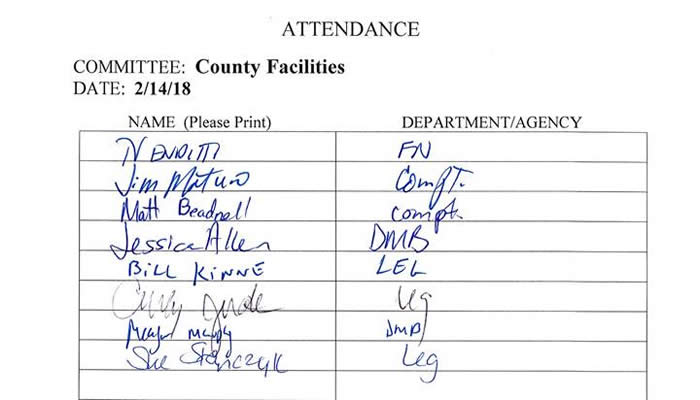
* * *
PUBLIC SAFETY COMMITTEE MINUTES - FEBRUARY 14, 2018
CHRISTOPHER J. RYAN, CHAIRMAN
MEMBERS PRESENT: Mr. Rowley, Mr. McBride, Mr. Bush, Mr. Jordan
ALSO ATTENDING: Mr. Holmquist; see attached list
Chairman Ryan called the meeting to order at 12:01 p.m. A motion was made by Mr. Rowley, seconded by Mr. Jordan, to waive the reading of the proceedings from the previous committee. MOTION CARRIED. A motion was made by Mr. Jordan, seconded by Mr. Rowley, to approve the minutes from the previous committee. MOTION CARRIED.
1. JUSTICE CENTER OVERSIGHT COMMITTEE:
a. Confirming Appointment to the Onondaga County Justice Center Oversight Committee (Jeffrey P. Marier)
A motion was made by Mr. Bush, seconded by Mr. McBride, to approve this item.
Mr. Rowley asked if the committee would also oversee the jail; questioned if it would be combined now that the Sheriff has taken over. Ms. Berger responded that the local law is very specific to the Justice Center, but it could be expanded.
Mr. Rowley said that he was fine with the motion but wanted to make the point. Chairman Ryan said that it was a good point.
Mr. Rowley said that if the executive is good with it, he would be as well. Chairman Ryan asked if the intention was to expand on the Oversight Committee to include Jamesville. Ms. Berger said that as it stands, the oversight is just for the Justice Center. Chairman Ryan said that expanding the local law is a good idea.
Passed unanimously; MOTION CARRIED.
2. FIRE ADVISORY BOARD:
a. Confirming an Appointment and Reappointment to the Onondaga County Fire Advisory Board (Richard Nemier, Ronald R. Foote, Jr.)
Chairman Ryan:
- Appointments cannot exceed three years; county executive appointments
A motion was made by Mr. McBride, seconded by Mr. Rowley, to approve this item. Passed unanimously; MOTION CARRIED.
3. A Local Law Protecting and Providing for the Health and Well-Being of Dogs in Onondaga County, and Amending Local Law No. 5 – 2017
Chairman Ryan:
- Local law in the process of being updated, same intent, to protect dogs left outside
- Proposed changes:
- Law specific to tethered dogs only, addresses previous concerns for work dogs and those on a leash for recreational use
- Time frame increased from 30 minutes to 2 hours for temperatures below 32° or above 90
Chairman Ryan distributed the following and said to excuse any typos. Ms. Berger does fantastic work but was under the gun.
REVISED DRAFT LOCAL LAW
Chairman Ryan said that he appreciates everyone attending, all the work put into this law, and their show of support. Realizing legislators just received this and have not had time to review it for questions, per his discussion, he will open this up for questions.
In answer to Mr. Rowley, Chairman Ryan said that an enclosed backyard would not be considered tethered.
Mr. Jordan questioned what if the dog is tethered but has some form of shelter for protection from the elements. Chairman Ryan said that this was not included because Adrian, the pit bull that died, was tether and had shelter, but was left overnight in 7° weather and froze to death. A dog can seek shelter but if the shelter is insufficient the dog will freeze to death, which is something we are trying to avoid.
Mr. Jordan asked if there was a reason why this is geared toward dogs and not pets or animals in general. The prior version was irrespective of breed and there are many factors that go into the health risk of animals, i.e. their breed, their coat, if there is wind-chill and if it is wet. Because there are so many factors with breed, even with this proposed local law, 2 hours in a colder climate may be too long for some animals. In some ways this may embolden someone to say that they can leave the animal out for 2 hours because the law says they can. Then the animal suffers frostbite or something like that. Having not seen the new version, is there any type of exception when other appropriate means are taken to keep the animals body temperature within limits to avoid suffering harm, i.e. sweater, booties, etc.
Chairman Ryan said that his intent in drafting the law was to stay general. He did not want to get mired down into specific classifications and have someone in violation of this law use that as a defense, to say their dog is a cold weather dog. The 2 hour time frame, for lack of a better word, was a compromise. Some people were not happy with 30 minutes, and if we go beyond that we run the risk of not protecting the dog, which breaks the spirit for the intent of the law. In regard to additional protection, police, peace and animal control officers, who will be enforcing this law, could then get into knit booties not being as good as those with rubber, or your Husky has Air Jordan’s on so it can stay out for 7 hours.
Mr. Jordan said that Senate Bill S841 is broader in some respects, not noting a particular time period, but does account for breed and such, and the punishment is more server than what is being proposing. If the state government passes a more stringent law it would render our action moot. Chairman Ryan responded he is taking that into consideration, including companion Assembly Bill A1473. However, he does not want to change the infraction fines as he does not know if or when the Senate and Assembly would take this up. If those bills are passed, we could amend our local law to increase the fines that haven’t changed from the original draft.
Mr. McBride said, for point of clarification, this is not definitive of breeds. It does not breakdown breeds. Chairman Ryan agreed.
In answer to Mr. Holmquist, Chairman Ryan said that invisible fencing would not be part of this.
Mr. Holmquist said that at the last session he suggested a public hearing as many reached out to legislators in regards to this local law. There is general agreement, amongst legislators, that a public hearing would be a good idea. Questioned if there has been any consideration of that, now that it is being amended, before it is voted on. Chairman Ryan said that a public hearing had not been set but there is public comment before the legislature at session. There were concerns about sending it back to committee, which we have done, and he has done everything he can to address a lot of the concerns and change the law. Currently a public hearing has not been set, but that is not to say he wouldn’t consider it. Mr. Holmquist encouraged the Chairman to consider it because he has heard quite a few concerns that haven’t been addressed by these amendments. Given the opportunity he would predict many citizens would come forward, if the public hearing was well advertised and at a convenient time in the evening.
Chairman Ryan asked if Legislator Holmquist had concerns, beyond what they already spoke of in general. Mr. Holmquist said that citizens conveyed a variety of concerns, which haven’t been addressed, and he thinks he has lists that he could forward. Chairman Ryan said that would be great.
Mr. Holmquist reiterated that as he said in session, it would be nice to have the citizens themselves come forward and rise the issues they have. All legislators could hear their concerns, and then have a chance as a legislature to address those concerns before passing something that may have unintended consequences, serious issues that we have not addressed, or things that we have not considered. Chairman Ryan said that beyond dog breeds that may be more resilient to cold weather, agricultural work dogs, or recreational uses, if there are, to use your words, “unintended consequences” or other concerns, it would be great if you could let me know.
Mr. Holmquist said that the first step would be to get the updated version advertised so that people would have time to come up with reaction to it. It is a big issue. He was surprised by the number of people who contacted him, and all seemed to be reasonable concerns. As he has said before, process matters and there is no downside to having public input. Not to delay it, but to have the appropriate process so all the issues can be properly vetted before passage.
Chairman Ryan said that the draft form has been distributed and will be circulated. A vote will not be taken, having just received the document, but these are the changes. We have addressed a lot of the concerns and I appreciate the work of the Human Society, Syracuse Pit Crew, Syracuse Police department, and everyone else present in support of this. It is a serious issue and hopefully we can get some legislation passed. Mr. Rowley said that the changes are headed in the right direction and he appreciates them. He is certainly optimistic.
No action taken on this item.
A motion was made by Mr. Rowley, seconded by Mr. Jordan, to adjourn. MOTION CARRIED.
The meeting was adjourned at 12:22 p.m.
Respectfully submitted,

KATHERINE M. FRENCH, Deputy Clerk
Onondaga County Legislature
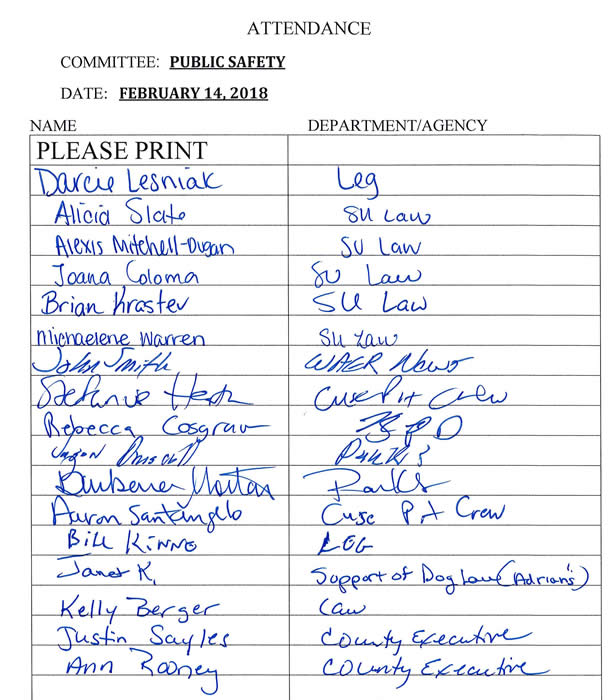
* * *
HEALTH COMMITTEE MINUTES - FEBRUARY 15, 2018
TIMOTHY T. BURTIS, CHAIRMAN
MEMBERS PRESENT: Mr. Rowley, Dr. Chase
MEMBERS ABSENT: Ms. Cody, Ms. Williams
ALSO ATTENDING: Mr. Knapp; see attached list
Chairman Burtis called the meeting to order at 9:30 a.m. A motion was made by Mr. Rowley, seconded by Dr. Chase, to waive the reading of the proceedings from the previous committee minutes. MOTION CARRIED. A motion was made by Dr. Chase, seconded by Mr. Rowley, to approve the minutes of the proceedings of the previous committee. MOTION CARRIED.
1. HEALTH DEPARTMENT:
a. Confirming the Reappointment of Indu Gupta, M.D., M.P.H. as Commissioner of Health for the County of Onondaga (Indu Gupta, M.D., M.P.H.)
Ms. Rooney:
- Dr. Gupta is completing the term of previous commissioner; this will be first full term appointment; dual appt. with NYS
- Currently she is getting County to accreditation (few months); 1 of first counties in NY to be accredited
Mr. Rowley asked how long the term is, and Ms. Magnarelli responded 4 years. Ms. Rooney stated the appointment of the Health Commissioner staggers the County Executive’s election, so it is not political.
A motion was made by Dr. Chase, seconded by Mr. Rowley, to approve this item. Passed unanimously; MOTION CARRIED.
Chairman Burtis stated that Dr. Gupta is a great asset, and took a tour of the Health Department. Chairman Burtis would like to do some tours with the committee. Dr. Gupta is a wonderful person, and has done a great job for the County.
Chairman Burtis said the resolution talks about the remainder of the unexpired term, and questioned Law if this is how it should read. At this point, Dr. Gupta has fulfilled the unexpired term. Ms. Rooney agreed. Ms. Magnarelli said she can take it out, and send an updated resolution.
Mr. Knapp said Dr. Gupta has taken a leadership role with the opioid crisis, and many other fronts, and has done a tremendous job.
b. Transfer from Health, Account 641010 Regular Employee Salaries, to Health, Account 694080 Professional Services, $312,610
Transfer from Health, Account 691200 Employee Benefits, to Health, Account 694080 Professional Services, $145,988
Dr. Gupta thanked the Chairman and Legislature for their confidence, and she will continue to do her best.
- Requesting transfer of money from 101 to professional services; 2 Pathologists and 2 vacancies
- Work with contract Pathologists to stay within guidelines; MEO is accredited; certain criteria have to follow
- Cannot exceed 250 autopsies per Pathologist; contract fulfills role to provide the service without affecting day to day
- Make the transfer for the rest of the year ($458,598); continue to do work without any barriers
Chairman Burtis asked Dr. Gupta to talk about the medical examiners, how few there are, and what brought the County to this. Dr. Gupta commented:
- Principle of economics - more than demand; opioids have put strain
- Pathologists looking at different places with enticing weather or certain city
- Had 4, but people move away for different reasons; out of the department’s control
- Contract Pathologists are excellent professionals; provide superb consultation services; work is not affected
- Contract Pathologists are NYC based; utilized by other counties as well
Dr. Chase asked if the County has the ability to grow their own (Pathologist) by mentoring someone in medical school or offering incentives. Dr. Gupta stated that Dr. Stoppacher is faculty at Upstate, and there have been discussions about creating a fellowship. The issue is that they have to have a Pathologist to give guidance. There needs to be trainers, and contract Pathologists cannot fill that role.
Dr. Stoppacher commented:
- Had discussion previously; good idea to get people in the pipeline; spoke to Upstate - all on board to go ahead
- To get accredited by ACG, they look at how much staff the MEO has, and are there trainers; given current status, it would not be accepted
- Something Upstate Pathology is interested in doing; attractive to them to have another fellowship
Dr. Chase asked if they could create a Pathology position that’s purpose is to educate and train new Pathologists. Dr. Stoppacher replied:
- Don’t believe it would be a viable position, because they cannot do just that
- Training is integrated into what Pathologists do, and they already train residents; progression is there, but they do not have the numbers to support it; if so, would like to pursue it
- There are 400 – 500 Board Certified Pathologists in the Country, and the need is close to 1,200
- Competition based on numbers, geography, etc.; magnified with opioid crisis, so it is a lot of work
Mr. Knapp said the Forensic Center is one of the jewels of the County with the way it’s run, and the work they do. Mr. Knapp asked about scholarships in exchange for graduating and working for the County for a set amount of time. Is it legal for the County, and is it something they could pursue? Dr. Stoppacher responded that there are national organizations involved in talking with the federal government concerning loan forgiveness, if the person works for a public health department in certain areas. That will probably take some time to happen. People coming out of medical school, residency and fellowship have significant loans, if that’s what Mr. Knapp is referencing. Mr. Knapp said yes. Dr. Gupta commented that the state of Ohio is looking into loan forgiveness. These things happen with private practices, visa programs and underserved areas. It is more of a policy discussion.
A motion was made by Dr. Chase, seconded by Mr. Rowley, to approve this item. Passed unanimously; MOTION CARRIED.
c. Informational Update
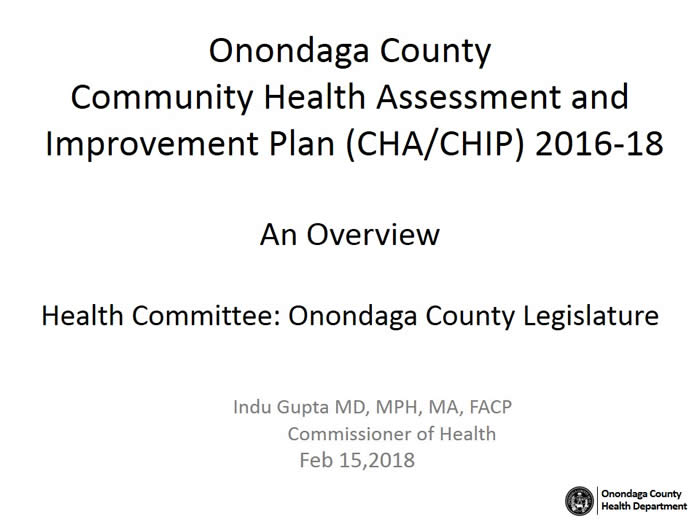 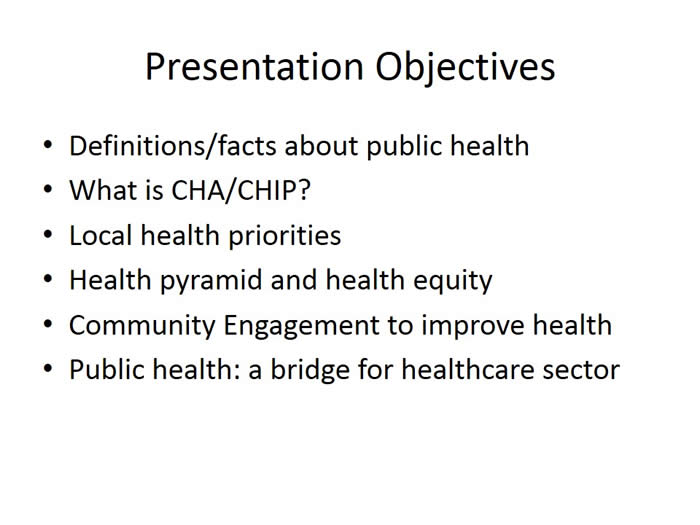
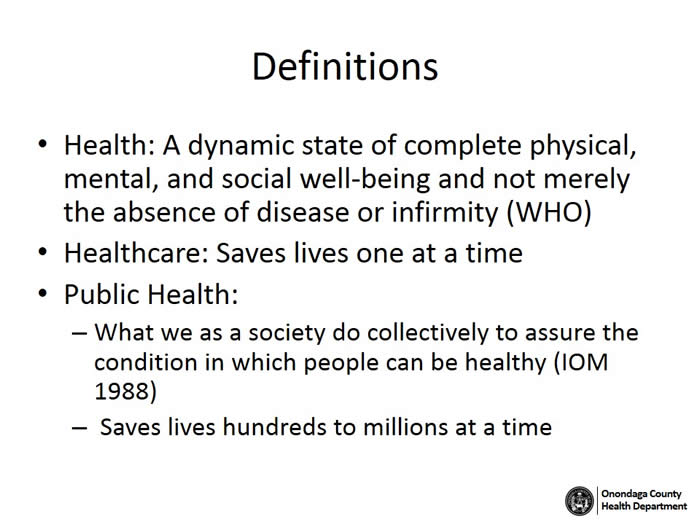 



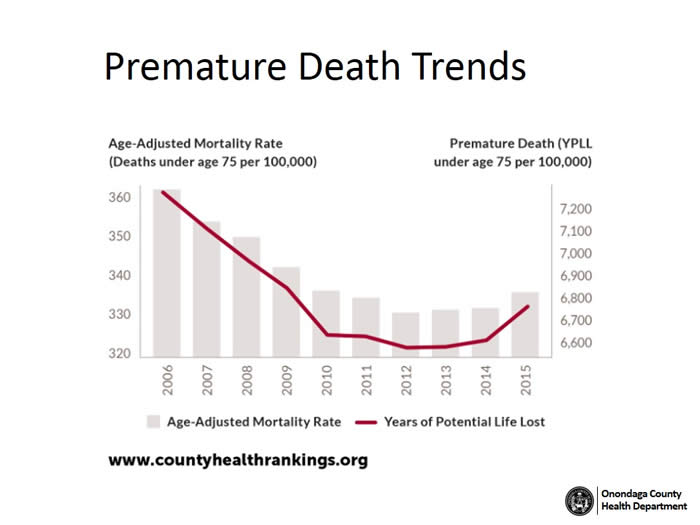
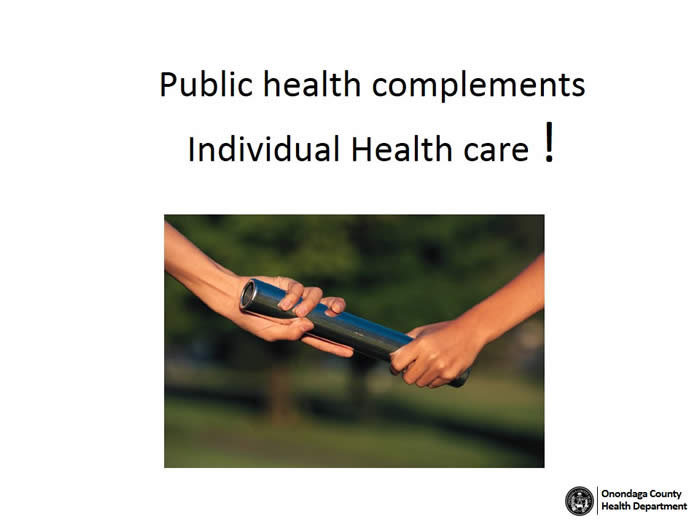
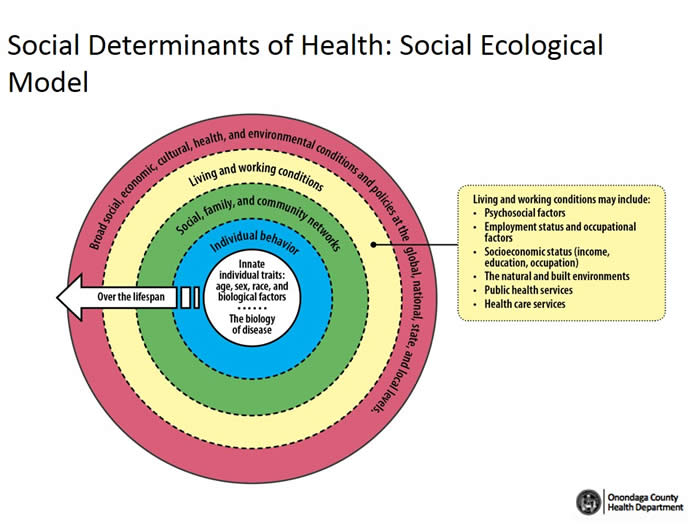
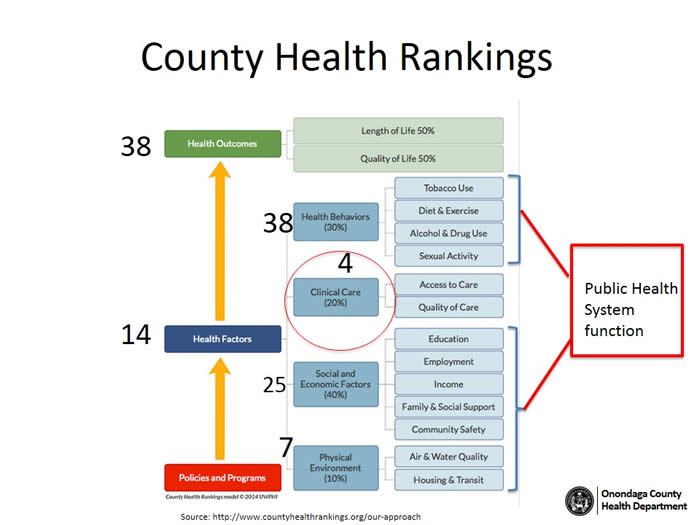
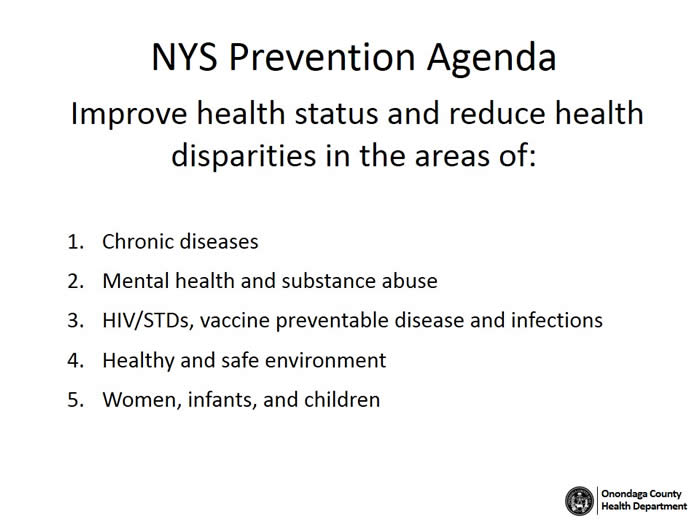 
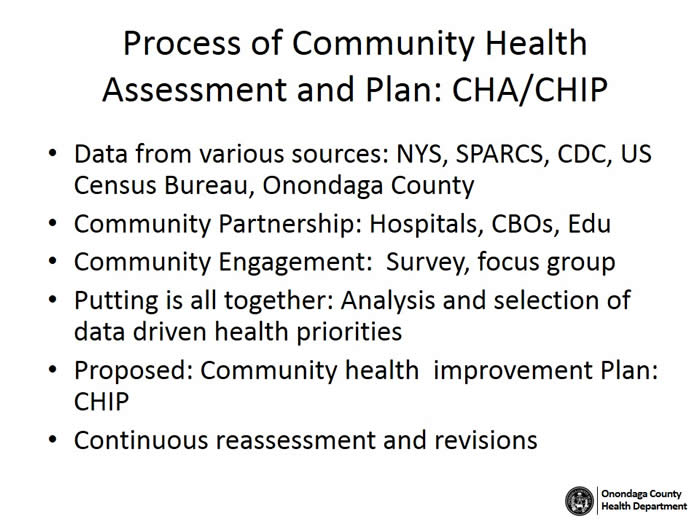 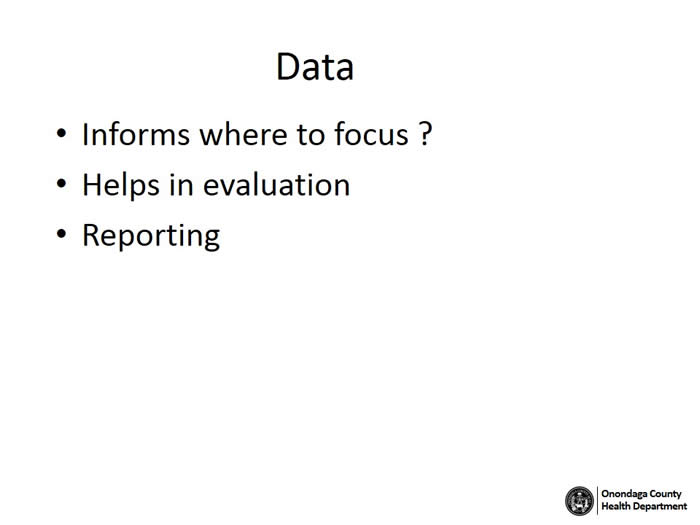
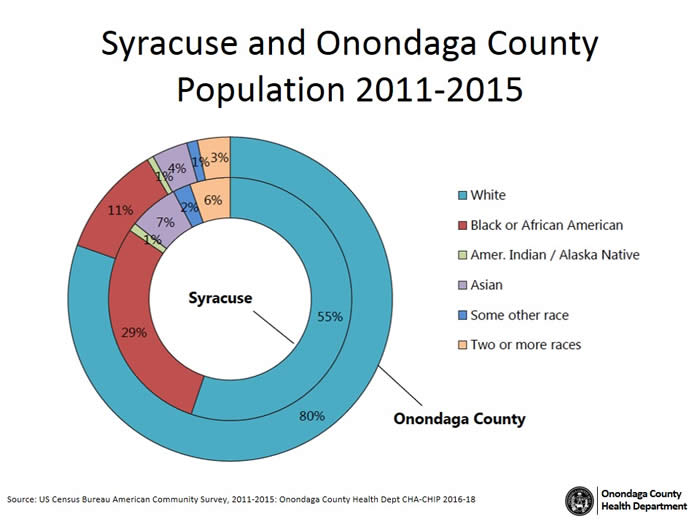

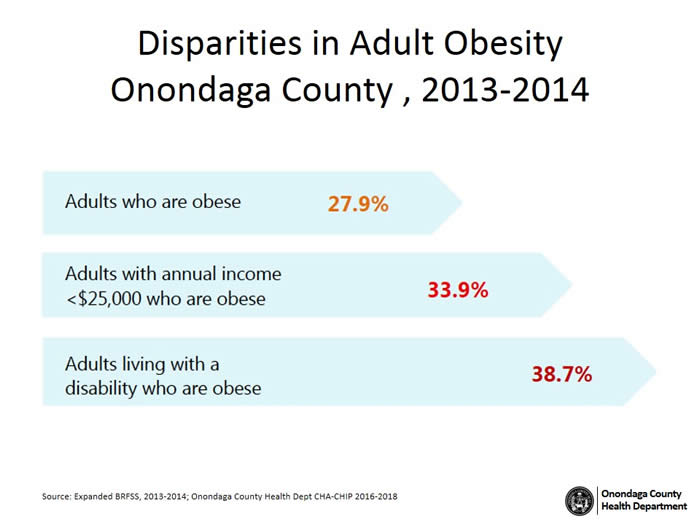


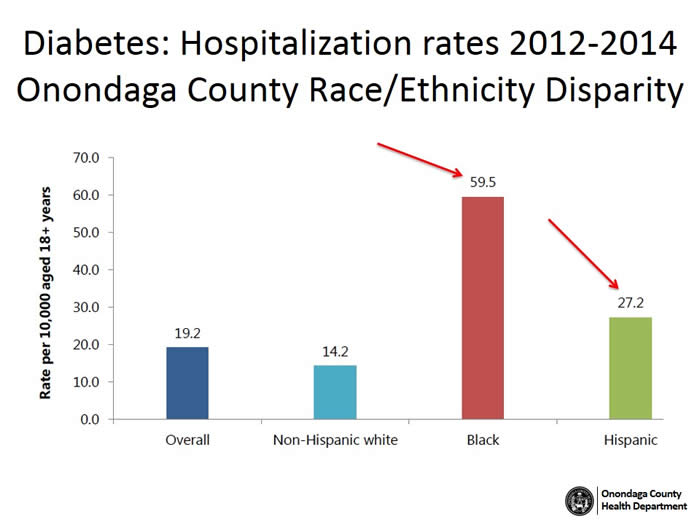

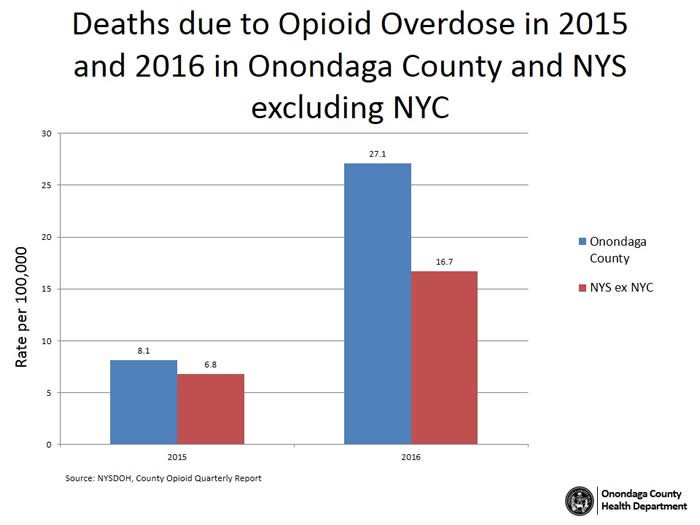
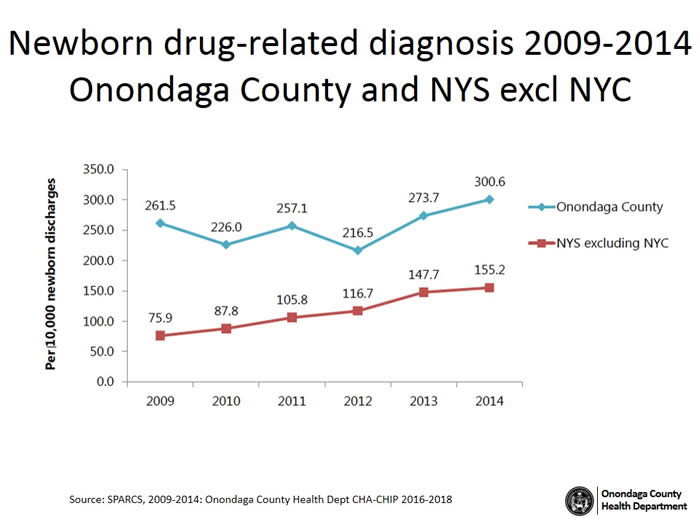

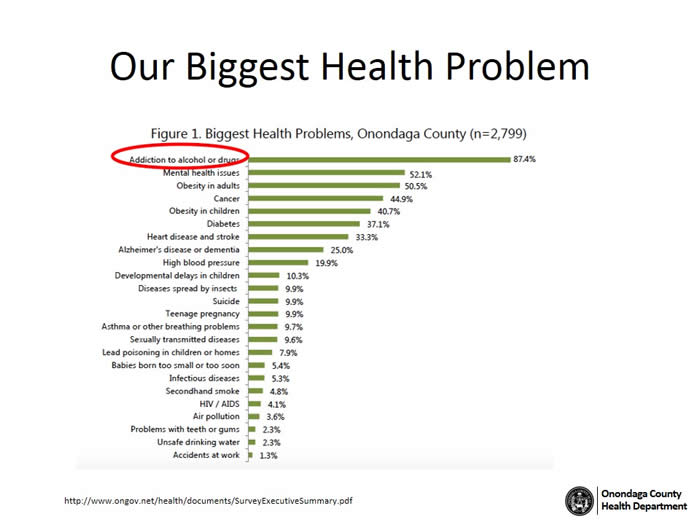
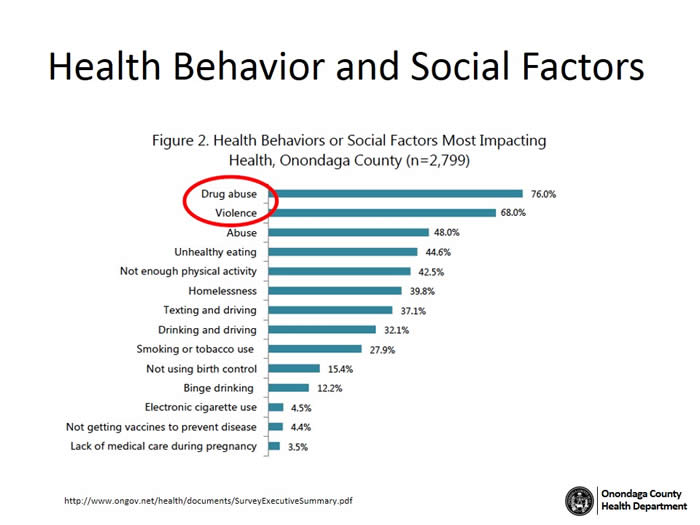

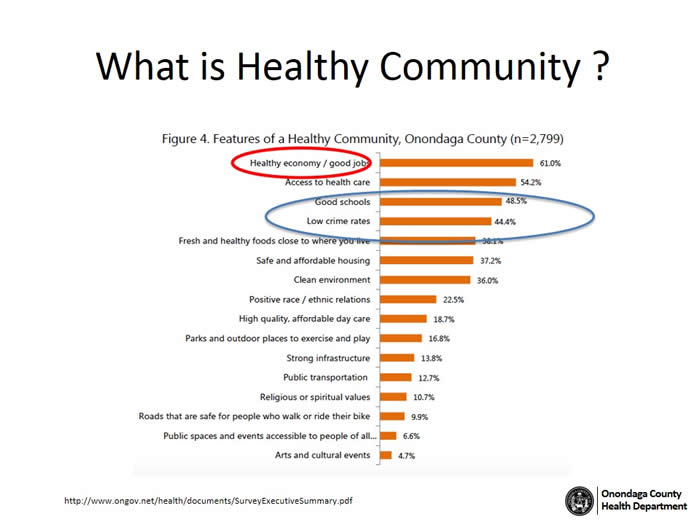
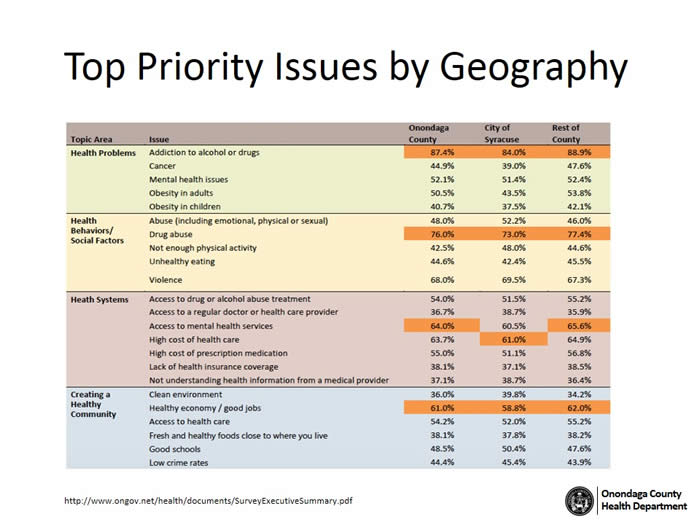
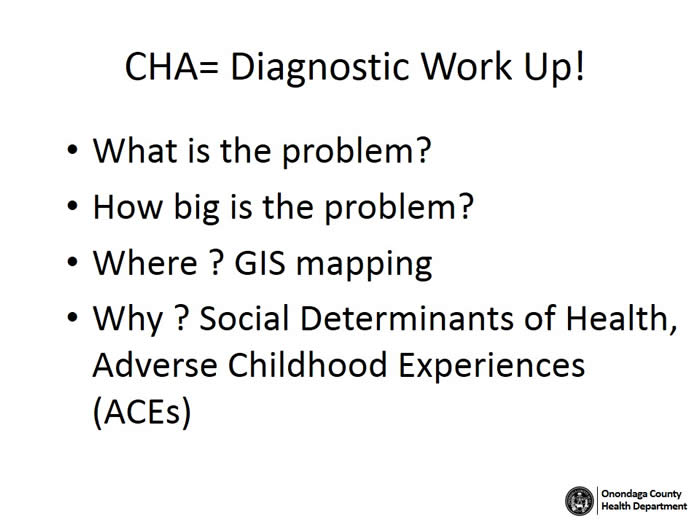 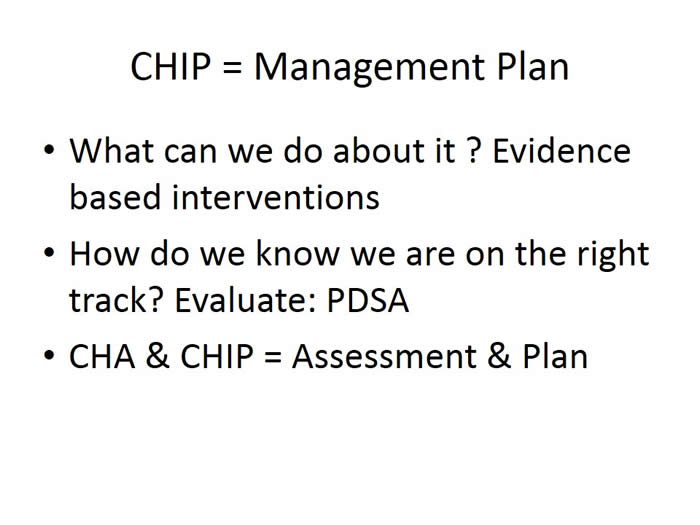

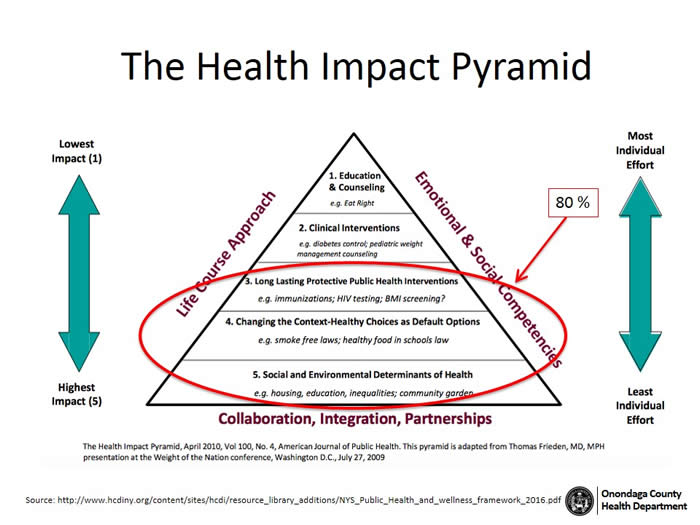
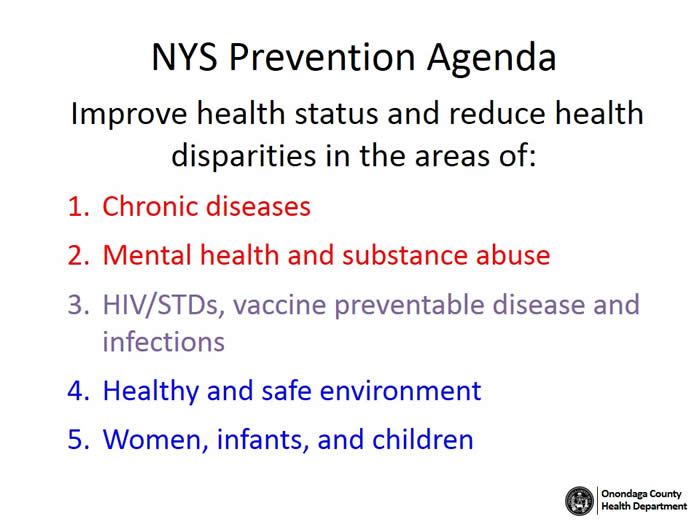
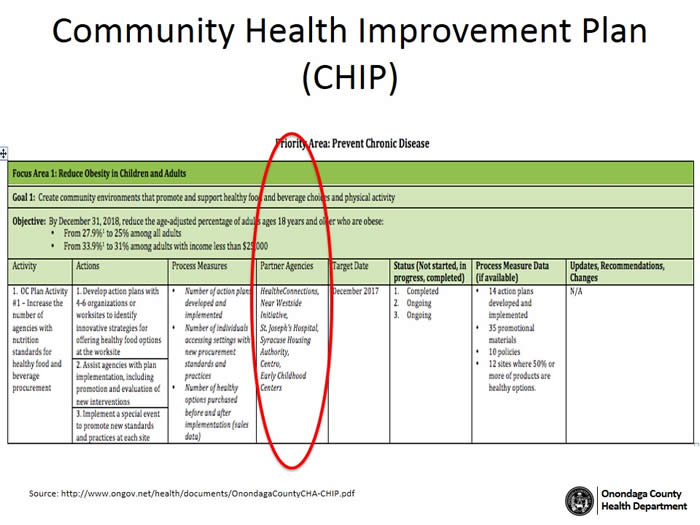
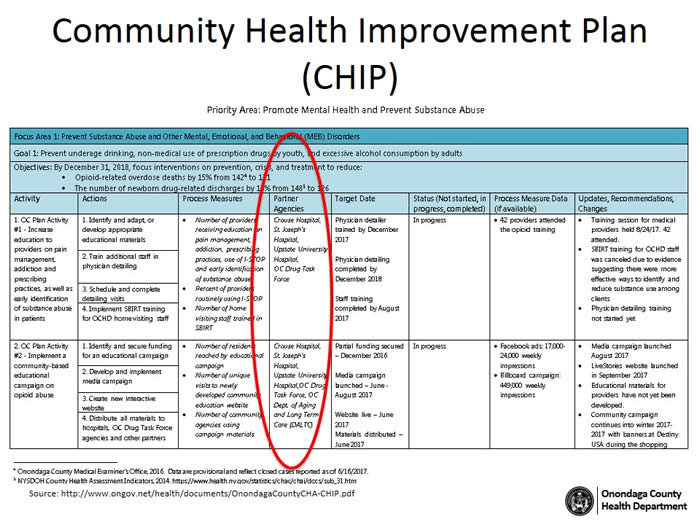
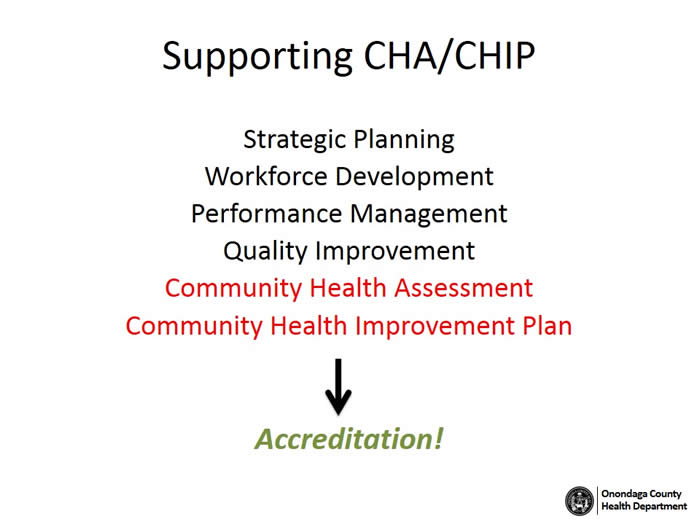 
 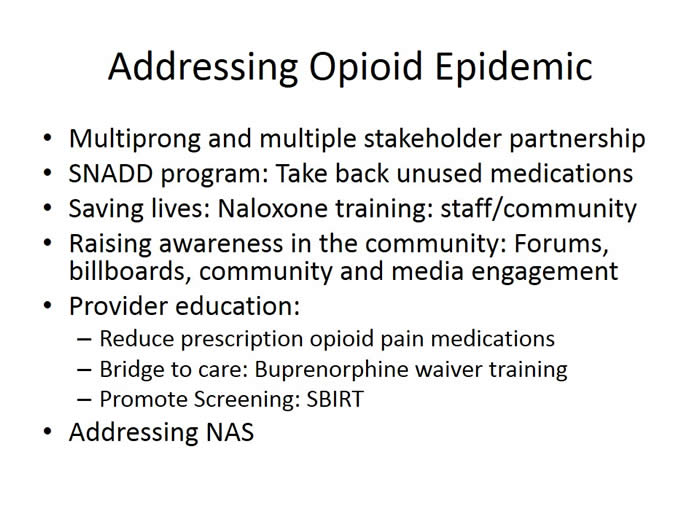

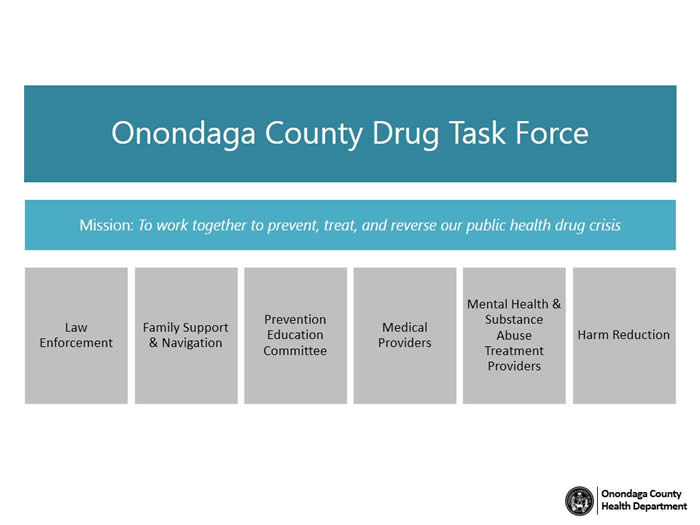

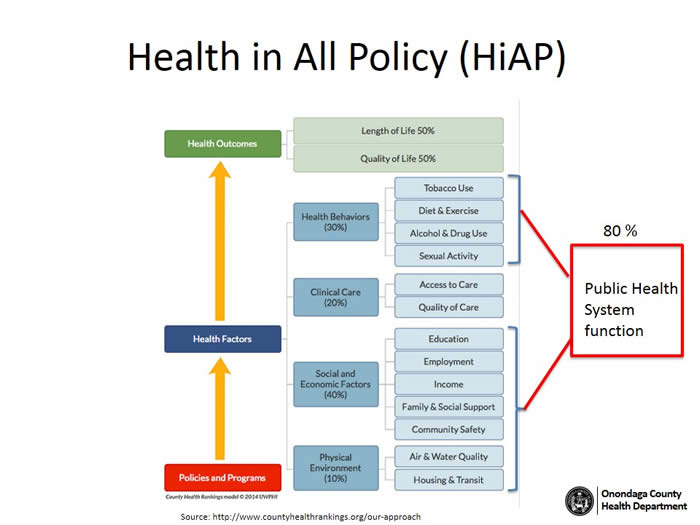
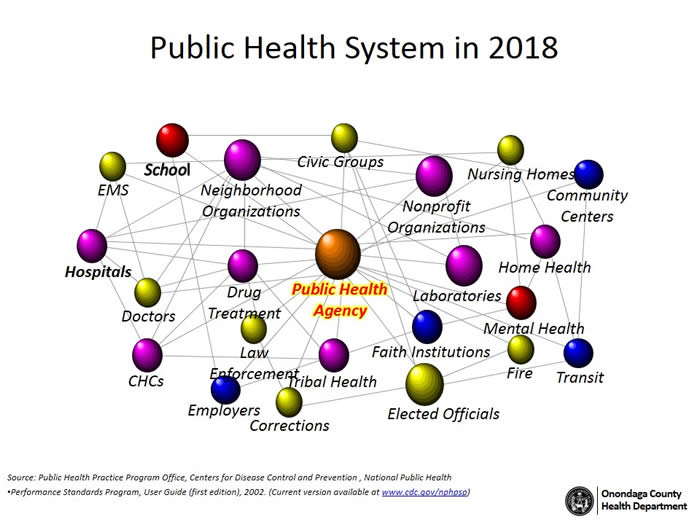

Onondaga County Community Health Assessment and Improvement Plan on file with the Clerk. For all information included in the presentation and the plan, please visit: http://www.ongov.net/health
Chairman Burtis feels this is a good place to start, and is a good baseline for the Health Committee.
Mr. Knapp asked about communicable diseases like Lyme disease, and how to track it more closely in the County. Dr. Gupta responded:
-
STDs including HIV, Hepatitis B, Hepatitis C, and also Lyme disease – all reportable diseases
-
Labs required to report data to NYS and to Onondaga County; STD data more straight forward
-
Lyme disease more complicated - treated in doctor’s office, and do not need test; positive blood test does not mean it’s Lyme disease; providers diagnose based on history, and treat early
-
There are some consequences of Lyme disease; complicated diagnosis
-
Had discussion and guidance from NYSDOH: Lyme disease is endemic (meaning in community)
-
Good percentage of ticks have it – Health Dept. promotes prevention: make sure grass and hedges are trimmed; when hiking, use precautions (long sleeves); do tick checks; contact provider if one thinks they have it
-
Lyme disease carried by different hosts: deer, mice
-
Do have data; but just because it might not be reported, does not mean it does not exist
-
STD rates are high; struggling how to handle this; have STD clinic, but see small percentage of patients; working with providers and education - safe sex important to sexual health; keep having conversations
Mr. Rowley said it is refreshing and comforting to know Dr. Gupta is here, and her passion is contagious.
The meeting adjourned at 10:28 a.m.
Respectfully submitted,

JAMIE M. McNAMARA, Assistant Clerk
Onondaga County Legislature
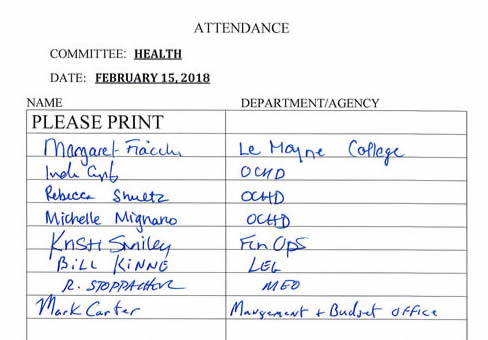
* * *
WAYS & MEANS COMMITTEE MINUTES
FEBRUARY 26, 2018
BRIAN MAY, CHAIRMAN
MEMBERS PRESENT: Mr. Ryan, Ms. Williams, Mr. Knapp, Mr. Plochochocki, Mr. Jordan, Mrs. Ervin
ALSO PRESENT: Chairman McMahon, Mr. Bush, see also attached list
A motion was made by Mr. Knapp, seconded by Ms. Williams, to waive the reading of the minutes of the proceedings of the previous committee. Passed unanimously; MOTION CARRIED. A motion was made by Mr. Knapp, seconded by Mr. Ryan, to approve the minutes of the proceedings of the previous committee. Passed unanimously; MOTION CARRIED.
1. COUNTY CLERK: Chris Plochocki, Deputy County Clerk
a. Authorizing New York State Reimbursement for 2018 Expenses of the Recording Officers for the County of Onondaga for Administration of Mortgage Taxes
- $541,339 total for reimbursement
- Down significantly from last year due to drastic decrease in IT expenses
- Reimbursement amount is based on a percentage of actual expense
A motion was made by Mr. Knapp, seconded by Ms. Williams, to approve this item. Passed unanimously; MOTION CARRIED.
2. ONONDAGA COUNTY CIVIC DEVELOPMENT CORP: Chairman McMahon
a. Confirming Appointment by the Chairman of the Onondaga County Legislature to the Board of Directors of the Onondaga Civic Development Corp. (Richard G. Zaccaria)
- Mr. Zaccaria is a town board member, VanBuren
- Has strong business background
- One board pick remains
Chairman May said that Mr. Zaccaria is very dedicated and will do a good job with this.
A motion was made by Mr. Knapp, seconded by Mr. Plochocki, to approve this item. Passed unanimously; MOTION CARRIED.
3. CNY WORKS, INC.:
a. Confirming Reappointment to the Bd. of Directors for CNY Works, Inc. (J. Ryan McMahon, II)
- County Executive’s appointment
A motion was made by Ms. Williams, seconded by Mr. Knapp, to approve this item. Passed unanimously; MOTION CARRIED.
4. REGION 7 FISH AND WILDLIFE MANAGEMENT BOARD: Chairman McMahon
a. Confirming Appointment to the Region 7 Fish & Wildlife Management Bd. (Michael Plochocki)
- County Executive’s appointment and Chairman’s suggestion
A motion was made by Mr. Knapp, seconded by Mr. Ryan, to approve this item. Passed unanimously; MOTION CARRIED.
5. HEALTH: Michelle Mignano, Deputy Commissioner
a. Transfer from Health - Acct. 641010 Regular Employees Salaries, to Health - Acct. 694080 Professional Services, $312,610; Transfer from Health - Acct. 691200 Employee Benefits, to Health - Acct. 694080 Professional Services, $145,988
- Transfer to cover contract pathologists
- Currently have 2 vacancies
- Get contract pathologies from NYC; come on average 12 days/month
- No change in budget
Mr. Jordan asked about providing pathology services for other counties. Ms. Mignano said that they do – Oneida is the largest, also provide services for some other small counties. The Oneida contract offsets some of the overhead and is a move to a regional MEO pathology service. It is working well. In answer to Mr. Jordan, Ms. Mignano said that Onondaga County does all of Oneida County’s pathology services. Onondaga County hires the forensic investigator; Oneida County pays for it. There is one assigned to Oneida; that person works in Oneida County; bodies come to Onondaga County, where an autopsy may be performed.
Mr. Knapp said that he attended the Health Committee meeting, where this was discussed at length. They also talked about working with Upstate Medical University to try to encourage people to go into this field and get them to stay here after they graduate, as there is a nationwide shortage.
Ms. Williams asked if Onondaga County’s salaries are comparable to what others pay, as this seems to come up quite often. Ms. Mignano said that two years ago it was increased, which makes Syracuse comparable to other mids and smalls (cities). There is a nationwide shortage; there is not a supply, but there is a demand. The big communities are, i.e. San Francisco, Denver, Las Vegas, NYC, Miami and there are other attractions in those markets. Rochester is in the same boat; the group out of NYC is being utilized throughout the state.
Chairman May asked about caseload. Ms. Mignano said that it is a little less than last year on average. Last year there was a tremendous increase in cases related to opioid abuse. She said that it is a great sign, but not a trend. In answer to Chairman May, Ms. Mignano said that they don’t generally have backlog.
A motion was made by Mrs. Ervin, seconded by Mr. Ryan, to approve this item. Passed unanimously; MOTION CARRIED.
6. WATER ENVIRONMENT PROTECTION: Tom Rhoads, Commissioner
a. Authorizing the Execution of Agreements to Accept Grant Funding from the New York State Environmental Facilities Corporation in Connection with Development of the Meadowbrook Limestone Inflow and Infiltration Reduction Facility Plan ($50,000)
- Accept $50,000 grant for Meadowbrook Limestone sanitary sewer evaluation study
- Have a NOV (notice of violation) from too much inflow and infiltration
- Engineering work underway; this will reduce the local share of cost
In answer to Mr. Knapp, Meadowbrook Limestone is the Meadowbrook section of the city, towns of Manlius, Dewitt, and villages of Fayetteville and Manlius.
Mrs. Ervin asked if there is any downside to accepting the money. Mr. Rhoads said that the work needs to be done anyway – would still have to pay for it and down the work without the grant
In answer to Mr. Plochocki, Mr. Rhoads said that they are still doing studying. This will help to organize the plans to help the extraneous flow from mostly municipal sewer systems. There is so much I&I that the plan can’t meet its permit limits. Mr. Plochocki said that this is a problem for all of the plants that hook into the city system; their system is so poor. Mr. Rhoads said that it is all of the municipalities. Mr. Plochocki agreed, adding that system have not been maintained.
A motion was made by Ms. Williams, seconded by Mr. Knapp, to approve this item. Passed unanimously; MOTION CARRIED.
b. Authorizing the Execution of Agreements to Accept Grant Funding from the NYS Environmental Facilities Corp. in Connection with the South Salina Street Green Corridor Project ($1,310,000)
- Accept $1,310 million grant from NYS EFC – Green Innovation Grant Program (GIGP) on South Salina St. corridor
- From East Calvin to East Newell Streets
- Engineering/construction of green street type project – if this money were not received, would still have to do green infrastructure in the sewer sheds
- Part of Midland sewer shed – combined sewer abatement budget – accepting this money will offset local share used in the project; offsets county’s costs
- EFC would like several small edits to this resolution: included authorizing resolution for Midland CSO; SEQR citation, delete “engineering” in first RESOLVED
- Required to do project as part of ACJ
In answer to Chairman McMahon, Mr. Rhoads said that they have just started the engineering work recently. That work will begin and include several public meetings --there will be a lot of interaction with the public. He said they are still at the very beginning of design. Chairman McMahon said that this is going south from Beachump Library towards the Valley, before the Tops Plaza. It is a heavy traffic area. It will be a big upgrade aesthetically.
Mr. Rhoads said that the green infrastructure is less expensive than the gray infrastructure. The County Executive’s green infrastructure is cost effective, and makes significant improvements to the community. It resolves the water quality issues, required to be resolved under the consent order. It improves the property and property values, but there will be some disruption. Chairman McMahon asked Mr. Rhoads to keep himself and Ms. Williams apprised of the schedule.
Mr. Knapp asked if this includes replacing the mains. Mr. Rhoads said that in some parts of this area the mains are owned by the city. The underlying infrastructure is not replaced unless found to be completely defective. The stormwater is stored underground and in bioswales along side of the road – preventing the stormwater from going into the combined sewers.
Mr. Jordan asked how this would have been funded if we didn’t get the grant. Mr. Rhoads said from the Midland sewershed – combined sewer abatement. This is a long-term, long-standing, combined sewer budget, reported out every quarter in the ACJ report. There is one for Midland, Harborbrook and Clinton sewer sheds; money is set aside to do this work. Mr. Jordan asked if it is cash. Mr. Rhoads explained that the legislature has authorized them with the right to borrow money. Mr. Jordan said that this grant would result in us borrowing less money. Mr. Rhoads agreed.
Chairman May said that everything fundamentally, philosophically makes sense, especially savings. It seems the only discretionary part is whether a conventional solution is installed or a green infrastructure approach is done. He asked for a ball park number of what is thought to be saved by taking this approach (green). Mr. Rhoads said that it is about a 40% savings over the cost of gray infrastructure. There are some green infrastructure projects that are “marquis” – they are slightly more expensive than gray. For the most part, over a long haul, the cost of abatement of combined sewer overflows is more cost effective, and we get the co-benefits of green infrastructure. Sewer work underground wouldn’t do anything to improve the street corridor or property adjoining. Chairman May said that is the cost of the abatement – what about the other side of it – system, longevity, effect. That’s not factoring into the 40%; it is common sense that if we get ground water out of the system, we are not beating on treatment capabilities. He asked if there are any dollars associated with that, or if there is an industry statistic. Mr. Rhoads said that every gallon of water that they treat costs roughly $2.05 - $2.10/gallon per thousand gallons. There is also the capacity of the plant. By taking the storm water completely out of the system, we are not over taxing the capacity of the plant, which also provides a capacity for economic growth. Not using sewer capacity for extraneous flow, gives the use of additional sewer capacity for sanitary sewer rather than clean water.
A motion as made by Ms. Williams, seconded by Mr. Ervin, to approve this item. Passed unanimously; motion carried.
7. ONONDAGA COUNTY PUBLIC LIBRARY: William Fisher, Deputy County Executive
a. Amending the 2018 County Budget to Make Funds Available in Connection with the Central Library Reconfiguration Project ($2,355,520)
Chairman May said that we all would have preferred a timeline and some other things. When this first came to him there were three facets of the proposal/project, that was worthy of getting it to the committee as soon as he could. One is a proposed savings; the other is a contractual obligation, and the last is the fact that there is a private business partner that at the point this provision of the contract was executed on, was not going to be receiving rent. He said from his perspective, it was good to get it to this committee and start the process as soon as possible.
Chairman May said that since that time, we have learned a lot about decisions dating all the way back to 2011 with respect to what the county wanted to do fundamentally – what the long term vision was. At that time, all of the wheels went into motion to see that these things happen. Prior legislatures’ approved borrowing. When this came back to the legislature after the grant came, there are two sitting legislators that voted against it, noting that he was one of them. Principally he wasn’t quite behind what we were doing. At the point we approved it and went forward, it was time to make decisions and make the most out of the project. That said, that is what he did with his decisions with respect to this. Back in 2014 there were many aspects of the process that were proven to be debatable. There were aspects of the process that every single member of the legislature would have preferred to have been handled differently – from communication, to contracts, etc.
Chairman May said that the issue before us is whether or not to “amend the 2018 budget to make funds available in connection with the Central Library Reconfiguration Project.” In other words, the last phase – putting this whole thing together. That is what we have been talking about, and is the matter at hand today. He said that he wants to discuss whatever members want to discuss - that is what we are here for, but wants to also stay focused on the decision of whether or not to use anticipated cash through the rent to fund as much of this decision as we possibly can. Chairman May said that we all will have a different perspective on this, and he respects every single one.
Chairman May said that as a legislator, this has been a lightening process--game changing as far as how we approach things. He commends everyone who has put skin in the game and done work. At the end of the day, it will put us in a place where we will ultimately make a decision. He said he would guess that if a vote were taken right now, it would be the same as it would be after this discussion. He wants to track toward taking that vote, but this is a chance from a Ways & Means perspective, to get the rest of it on the table and cast our vote. He asked that all engage with the rest of this respectfully and productively.
Mr. Fisher said that he thought he heard that Mr. May said that he voted against the local law, and that Legislator Jordan said that he voted against it. That local law was adopted unanimously, 17 – 0. Chairman May said that he was referring to the bonding in 2013. Mr. Fisher said that he didn’t think Mr. May was here when the bond was voted on – and challenged what Chairman May or Legislator Jordan voted against. Chairman May explained that it was bonding for $4.7 million because $500,000 was already presented. He added that it is not even germane; that is water under the bridge. Chairman May began to explain that he didn’t love the decision in the beginning, but was here today…(inaudible) as Mr. Fisher interrupted and said that “facts are usually germane, but in this case they don’t have to be I suppose.”
Mr. Fisher said that the resolution a month brought forward a month ago is different than the one today. Last month the resolution asked for an appropriation to carry the expenditure side of this project through the end of the lease with SUNY Upstate. They had asked for $4.3 million – would have carried through to October 2028. Before it almost got to the floor of the legislature, it was reduced down to $2.355 million, which is specifically the amount of the lease buy out. That simplifies what is being looked at – whether or not to fund a lease buy out. This is not providing for the appropriation needed to get through 10 years. It means that the second half of next year, they will come back, as they will be out of money in that project.
Mr. Fisher said that on the legal side of things there was a lot of discussion and misinformation about the county executive’s powers and duties with respect to contracts. It comes in under the Charter, Section 2102. There was a lot of misinformation and misstatement of facts with respect to the local laws passed in Nov. 2014. He said that first of all, the county executive had the authority to enter into the lease; second of all, she has not exercised the option. An option to purchase property has two parts to it; one is the notice that we intend to do this, which was given in the lease. The second is actually showing up with the money. The county executive makes contracts within authorized appropriations. He said that what is being asked, and was asked a month ago, is to authorize the appropriation needed to exercise the option. If you chose to not authorize that appropriation, then the option period will expire. “To all the folks that were saying she didn’t have the authority to enter into this binding purchase agreement, it’s an option. He said that the legislature gets to decide whether or not to exercise that option. “If we don’t, we believe it will cost us dearly.”
Ms. Berger addressed Sections 21 and 22 of the Charter. She said that in Section 2102 the county executive executes contracts on behalf of the county. There are certain instances where the legislature does give approval to the contracts, and that approval was given in the local law in 2014. The types of approvals involve real estate purchases. It was stated in the local law that there was approval for an option to purchase; it was included in the lease terms. The county executive to provide notice of intent to exercise the option, that couldn’t be fully realized until the money was available, which is why we are here today. She said that she would be happy to explain any legal questions about it.
Mr. Fisher said that the first question before us is “do we exercise that option?” The lease agreement has given notice that we intended to exercise that option by December 31st. This resolution appropriates $2,355,520 into a grant project. The grant project was established in 2014. With this appropriation, the appropriation is against future revenues from the asset, 60,000 sq. ft. of office space that the county owns on the 4th and 5th floors of the Galleries. Today there is a lease with SUNY Upstate Medical University for 10 years. The lease as a 5 year option. He said that he had it wrong when he spoke to Ways & Means Committee last month. There are built into the lease with SUNY Upstate, 2 five year options, which he forgot about. It is solely SUNY Upstate’s option whether or not to elect those. He said that we are not counting on that in terms of this resolution. The $2.355 million should be taken care of within the first 10 years.
Chairman McMahon said that part of the discussion that merited more diligence was the cost per square footage, which was brought up by one of our colleagues – looking at this as residential real estate deal. That is difficult in a commercial real estate deal; there is a cost basis based off of actual rents, which is really how you look at it. At his urging, the administration went back and found other comparables that more than supported the cost of square footage if it were looked at as if buying a house. It is not the right way to do it, but we looked at them that way. He asked the administration to reach out to probably the best real estate broker. It is not a full blown appraisal, that that would have taken more time, but the information is all there to look at, put together by John Clark, Pyramid Brokerage Company. Chairman McMahon said that he has two other comparables that he can provide, if there are still questions on the value of what we are buying the property for based off of square footage. He noted again that it is really not how commercial real estate transactions are done, but even if it were, there are enough comparables within a half-mile radius of the property to support the decision being asked to make.
Chairman McMahon distributed the following:
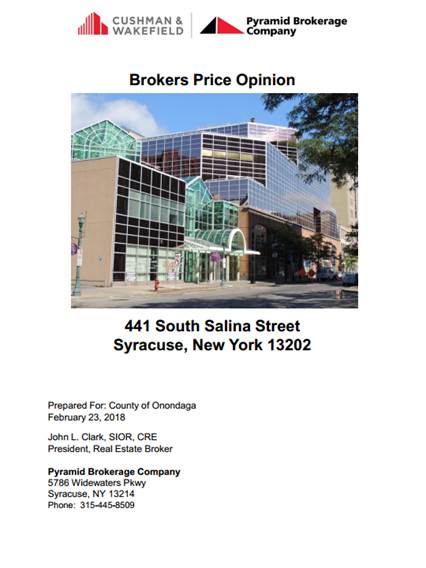 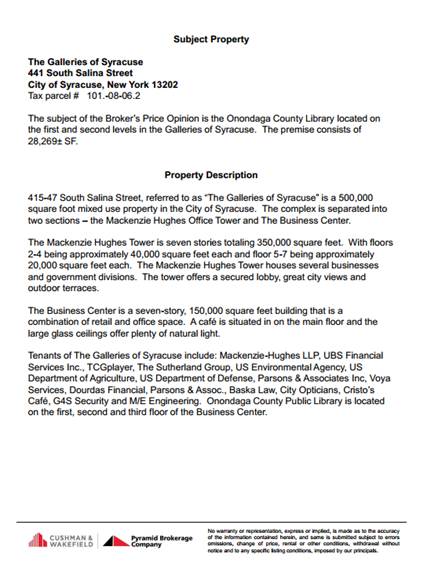
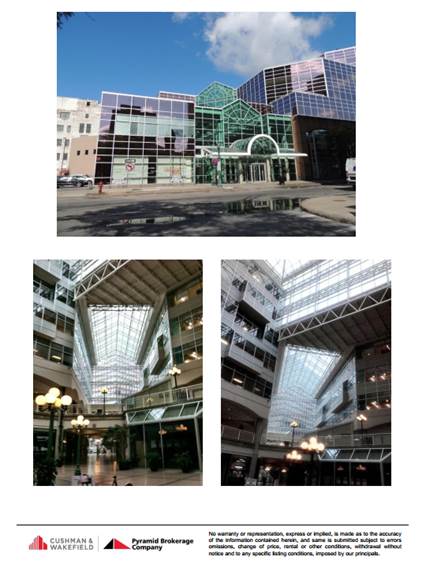 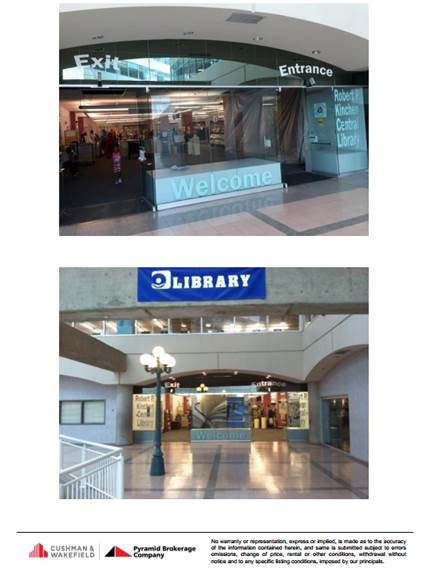
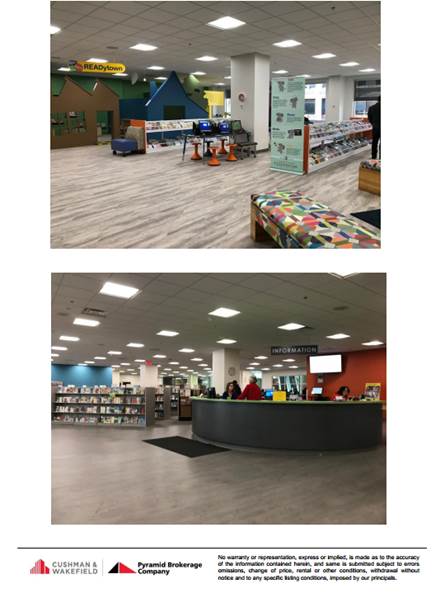 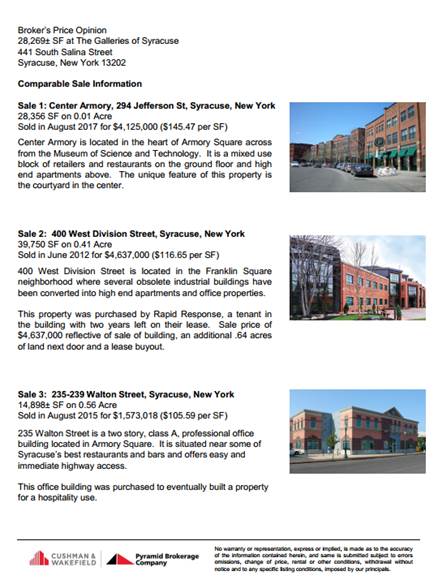
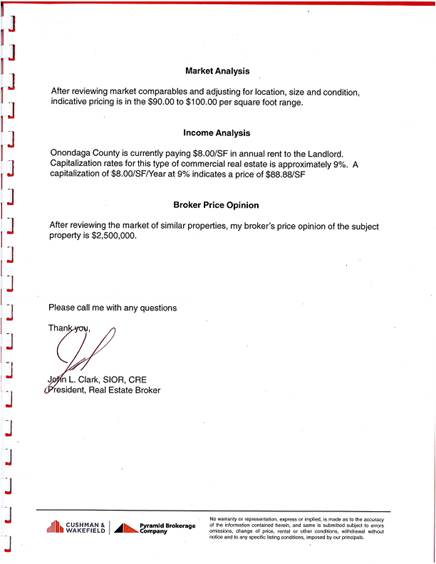
Mr. Fisher said that in November 2014, there was a price of $2,355 million set over 3 years. That number didn’t come up out of the air. He said that he personally did due diligence in the course of negotiating with the landlord, owner of property. He said that they spoke with real estate companies at the time--looked at at prevailing cap rate was at the time. When looking to buy commercial real estate and get an appraisal, you follow one of the three methods: 1. what the replacement cost would be – never looked at it; it would be very, very expensive to replace it; 2. comparables; 3. income. The income comparing it to is $8/sq. ft. Depending on what cap rate you pick, you come out with an analysis based on income. What John Clark, Pyramid, did was similar to what was done more than 3 years ago. Mr. Fisher referred to last page of Broker’s Price Opinion regarding the income analysis. Regarding the market analysis, we came up with 3 specific properties, all downtown: Center Armory sold for $145/sq. ft.; 400 West Division St. sold for $116/sq. ft.; 235-239 Walton St. sold for $105.59 /sq. ft. Mr. Fisher stated that this (Brokers Price Opinion) is not a formal appraisal--that would take longer and would cost more money. He pointed out that money had to be spent on this. He read the Broker Price Opinion from Mr. Clark “After reviewing the market of similar properties, my broker’s price opinion of the subject property is $2,500,000.” Mr. Fisher stated that it is not different from the information from over three years ago. He said “but if hearing it again helps you, then that is great.” Chairman McMahon said, for the record, that the information we asked for that Mr. Fisher is referencing, was not provided three years ago. “It is a little unfair to discuss that we had it available to us; you were not available to us, nor was the back up material that we asked for.” He added that this was a good outcome, and the administration was very wise to go forward with it and spend that money. Mr. Fisher said “that is information that I had, when I personally negotiated the price, that information was available. I believe it was discussed with the legislature. I don’t know if there are minutes to that affect or not, but the number was not picked out of thin air.” He said that he believes that is why it was passed unanimously when the legislature gave the right to exercise the option at that price.
Mr. Fisher said that that other question is: “If we are going to fund the lease buy out, how do we fund it?” The county executive has proposed funding it out of the same project that pulls in the revenue from the asset. There is a lease agreement, a binding agreement on SUNY Upstate. They have money like what we have –if there is no money appropriated, they can get out of it. To the best of our knowledge, SUNY has never backed out of an agreement, and they are the largest employer in Central New York. The agreement is through 2028; they have the sole option to extend another 5 years, and then 5 years beyond that. “We are proposing to appropriate funds in the project knowing that there is a lease, that the money will come in; knowing that the money has to be spent.” He added that there is not enough in the project to carry all the way through the lease. He reiterated that they will be back here the 2nd half of next year to appropriate funds to keep operating the property under the terms of the lease.
Mr. Fisher said that this is not the only way to finance it – could borrow money, could transfer funds from general fund, could move fund balance to general fund. The approach chosen would use the revenues that will come in from the lease of this property to finance the acquisition of other property. It is other space in the library that we don’t own – 28,000+ sq. ft., part of the commercial unit owned by Onondaga Galleries, LLC. He said “why hang other expenses on the taxpayer.” He said that they feel the better way to do it is to take the asset that we already have, fix it up, make it ready for lease, go find a commercial tenant, use proceeds from that lease to pay for the property that we want in order to get the library that we need. The size of the library was reduced dramatically, by nearly 30%; it is now a more attractive library and opens on Salina St. He said that we needed to get property that we didn’t own, and bond counsel made it clear that we either had to lease it over 23 years or we would need to buy it. Improvements couldn’t be made without control of it. There is no choice other than a lease or a lease buy out. He said that if you want to pay the lease for 23 more years, it is over $2 million more; it nets out to about $1.7 million after you figure in the increase amount of condominium unit charges.
Mr. Fisher said that there was a misunderstanding at County Facilities Committee, where there was a look at the time value of money of the $2.355 million. He said “you neglected to look at, or maybe we didn’t correctly explain to you, there is also time value of money associated with the money we pay for as a lease.” Mr. Morgan sent members an analysis that compares lease vs. own. The calculation done was not actually net present value. Net present value is when you are receiving a revenue stream; what was done was a future value calculation. Take the $2.355 million; if you don’t pay it in cash, you still have it to invest; calculate whatever interest rate you want – that is the amount of gain you would get by investing it, looking at some point in time, i.e. 23 years. There is also a gain when $28,000 is paid a month in rent. If you don’t make those rent payments for 23 years, you still have that money; you invest it and there is a future value to that. It turns out that is more valuable. He said that the analysis that Mr. Buckel was pushing, that the time value of money works against this, is actually incorrect. The future value gained from investing the rent that you don’t have to pay, is more than the gain from a lease buy out that you don’t have to pay. He said that the financial analysis is very simple; there was a lot of confusion or obfuscation for whatever purposes.
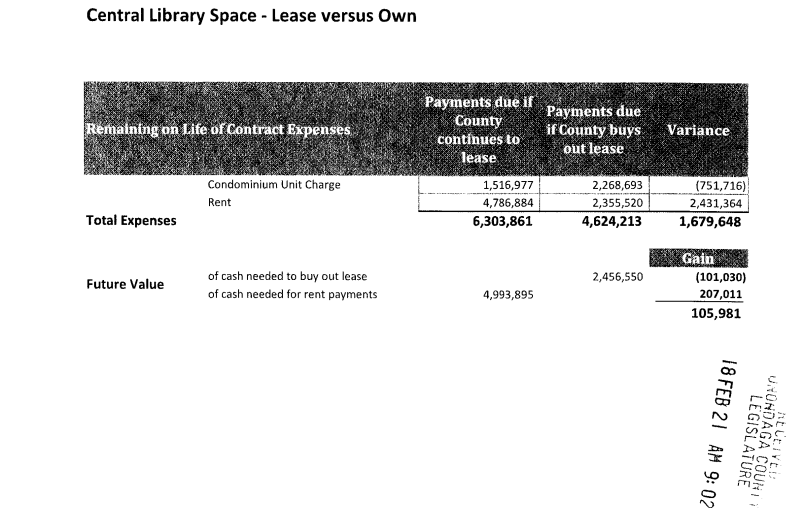
Mr. Ryan referred to the net gain in the variance, $1.67 million, and asked if that is what is saved through the rent that we are getting through SUNY Upstate through 2029. Mr. Fisher said that it is a time value of money thing. Two alternative investments: 1. invest the $2.355 million by not funding the lease buy out; 2. invest the annual rent over the next 23 years. Either way you pretend as though that money gets invested at some rate. Because the rent ends up being so much more money, the gain from investing the money that you didn’t put into the rent outweighs the gain that you would have gotten from investing the $2.355 million. Mr. Ryan asked what year the savings kicks in. Mr. Fisher said that they took the end year of the lease; Mr. Morgan said that he used 21 years.
Mr. Knapp asked if the lease with Upstate, per square foot or on a monthly charge, is flat for the entire term or if it escalates. Mr. Fisher said that the analysis presented is flat, but there is additional rent that will be due. They pay $12.40/sq. ft. throughout the lease. If they renew it, it will still be at that amount. Mr. Knapp said that there is incentive for them to do it and keep it the same. Mr. Fisher added that there is additional rent – certain operating expenses that were measured in 2017, and they are on the hook to pay additional rent in 2018. That is typical in commercial leases. Taxes won’t go up, as we don’t pay taxes – it’s hard to estimate how much of that additional rent will be; it hasn’t been built into any calculations.
Mr. Knapp asked if we keep paying the lease for 21 years - doesn’t think the library is going anywhere for a long time - what happens at that point. Mr. Fisher said that the bonds would be paid off, so we could walk away legally – could walk away from improvements and abandon it. We could say that we aren’t do the library there anymore. Mr. Knapp said that if it is renegotiated it would probably be more than $8/sq. ft. at that point.
Mr. Jordan said that he understood there was a certiorari proceeding between the Galleries and the county, essentially as to what the value of property is for tax purposes. He assumes that the fair market value reflected on the tax rolls reflects what the outcome of that proceeding was -- $7 million was the fair market value for tax purposes. He said that he thinks the county owns less than half the total square footage at the Galleries, but Mr. Clark says 50/50. He said that 28,269 sq. ft. would be roughly 25% of the total square footage that the Galleries organization owns. At a fair market value of $7 million, it would mean that portion of it would be worth about $1.7 million. That is almost $500,000 less than what we are paying for it.
Mr. Jordan said that it is unclear whether the Galleries is actually paying property taxes right now. He is not sure why they wouldn’t be; but assuming they are, the tax base for the property they own should be going done by $2.35 million. We would be losing tax revenue because of the decrease in taxable property that the Galleries owns. He asked if there is an estimate of what that property tax reduction would be. Mr. Fisher said that there is no certiorari between the Galleries, LLC and the County of Onondaga. Whatever tax actions have been taken, have been against the City of Syracuse. Mr. Fisher said that he is not familiar with those proceedings. He said that he doesn’t know that anyone buys real estate based on the outcome of certiorari legal actions. Maybe they do, John Clark did not take that into account. He said “If you think that $2.355 million is too much, then you should vote against it.” Mr. Jordan said that his question is “what is the estimated reduction in tax revenue?” Mr. Fisher said that the property is based on the leasable space as well as the common area space. The common area space belongs to us in some percentage. He does not know how that factors into the taxes. The county doesn’t pay anything toward the common area in maintenance charges. There is complex language that says that until they get a certain amount of retail space in that property, the county won’t pay any CAM charges. He does not know how much the common area fits into the overall tax assessment by the City of Syracuse. He said that he recollects that there was approximately 280,000 sq. ft. of leasable space. When they sell 28,000 sq. ft. to use, it will reduce the leasable space by approximately 10%, but he does not know if that means the tax bill goes down by 10%.
Mr. Morgan said that if he understands Mr. Jordan’s question, he is concerned about the loss of tax revenue if we buy it, and that square footage becomes county owned. Mr. Morgan said that there is no loss of revenue. Moving forward, the city budget is the city budget, so is the county’s. It will be spread across whatever taxable value there is. If it is no longer taxable, it it spread to the taxpayers in the city and the county. If the property becomes nontaxable, they won’t be charged taxes, but the rest of the remaining taxable properties will. They won’t lose tax. Mr. Jordan said that right now the Galleries pays a certain amount of money in real property taxes on the value of what they own in the Galleries. They are reducing the amount that they own, so they are reducing the value of what the Galleries organization owns in the Galleries. By reducing the property value, based upon the assessed tax rate, it reduces their overall tax bill. Mr. Morgan agreed. Mr. Jordan said that his question is, “how much does it reduce their tax bill?” Mr. Morgan said that the question was how much tax revenue are they going to lose. He said that he answered the question – you aren’t going to lose any tax revenue. Mr. Jordan said that he doesn’t see how tax revenue isn’t lost if their tax bill is going down. Mr. Morgan said “because everyone else’s is going up. Mr. Fisher asked if it is understood what it means to levy a tax. It is revenue. If there are $34 million in city tax, which they do year after year, it is $34 million. “If these guys pay 10% less next year, it is still $34 million of revenue.”
Chairman McMahon said that Mr. Jordan is right – they would not be paying taxes on that property – that property would be tax exempt. Mr. Morgan is correct – when the county has a flat levy in the budget, the tax rate goes down because there is growth in the assessment, in most cases. What happens is more people are paying into the taxes; because more people are paying in, the levy is flat – everybody else gets a little cut. In this case, the municipality is still going to levy the same amount of money no matter what. It is whether or not property comes off the rolls and other property assessments increase. It all balances out. The municipality has the decision to raise the levy or keep it flat. If we buy this property, it will not be a taxable property, but there won’t be any revenue lost. Mr. Fisher said to calculate what the reduction in their tax will be is a decision of David Clifford, City of Syracuse Commissioner of Assessment, will make. Their commercial unit, the leasable space within the condominium, is being reduced by approximately 10%. In fairness, you might think that Mr. Clifford would reduce it by 10%, but there is also the common area – it is not being reduced. It could be that the tax bill goes down by less than 10%. They aren’t a huge taxpayer in the first place; that is all the information that there is.
Chairman McMahon said that this property may have a PILOT on it; at one point they did. Mr. Jordan said that at some point in time they have to pay taxes. He said that inherent in his question, the assumption that if we don’t change tax levies against anybody, we don’t increase the assessment of other people’s properties, we don’t increase the tax rate, then there would be a decrease in the tax revenue that is received. To say that it is somehow going to be compensated for by increasing the levy or increasing the value of the properties, is misdirection.
Mr. Ryan said that it would only be based on the assumption that there are no other taxes that are going to be raised. If taking $2.355 million off the tax rolls, there may also be an increase in raising taxes – he said we will never know. Chairman McMahon said that any nonprofit doesn’t pay property taxes, unless using it for a profit making mechanism – we are nonprofit. Mr. Ryan said that a better question is “what are the future tax implications for the rest of the City of Syracuse if $2.355 million comes off the tax rolls?” It is a hypothetical because we don’t know if the tax levy is going to go up or down. Someone might move in and take over a vacant building and put $150 million of taxable assets on. Then the tax levy is going to go down in the City of Syracuse.
Mr. Fisher said that this is all “fun to think about, but how does it bear on the resolution that is in front of you?” Mr. Jordan replied that it is an element of the cost. Mr. Fisher said “if it bothers you, then vote against it and the county taxpayer will spend another $2 million as a result of that vote. Mr. Jordan said “even by your own estimate, it is not $2 million, it is $1.6 million.” Mr. Fisher said it is $1.8 million.
Chairman May said that the information gained with respect to process and on the library itself has been great. He commended everybody for due diligence with this.
Mr. Plochocki questioned what happens in December 2019, if this isn’t approved. Mr. Fisher said that the option period would expire – would no longer have the option to buy the property. Chairman McMahon said “at that price”; he added that we would have to renegotiate an option. Mr. Plochocki said that there is a bill that was put forth by the Galleries. Chairman McMahon said that the legislature did not consider that for a vote at the County Facilities Committee. Chairman May noted that it was discussed at County Facilities Committee, but not voted on.
A motion was made by Ms. Williams, seconded by Mr. Plochocki, to approve this item. AYES: 6 (May, Knapp, Plochocki, Ervin, Williams, Ryan); NOES: 1 (Jordan). MOTION CARRIED.
8. PURCHASE:
a. Revenue Contract Report - NONE
9. LAW:
a. Litigation Update
A motion was made by Mr. Jordan, seconded by Mr. Knapp, to enter into executive session for the purpose of discussing pending litigation in the following cases: 1. Jane Doe v. Onondaga County, Onondaga County Department of Social Services, et al; 2. V. W. a minor, R.C. a minor, C.I. a minor, et al. v. Onondaga County Sheriff and Syracuse City School District. Passed unanimously; MOTION CARRIED.
A motion was made by Mr. Jordan, seconded by Mr. Knapp, to exit executive session and enter into regular session. Passed unanimously; MOTION CARRIED.
Chairman May stated for the record, that no action was taken during executive session.
A motion was made by Mr. Jordan, second by Ms. Williams to adjourn the meeting at 10:40 a.m. Passed unanimously; MOTION CARRIED.
Respectfully submitted,

DEBORAH L. MATURO, Clerk
Onondaga County Legislature
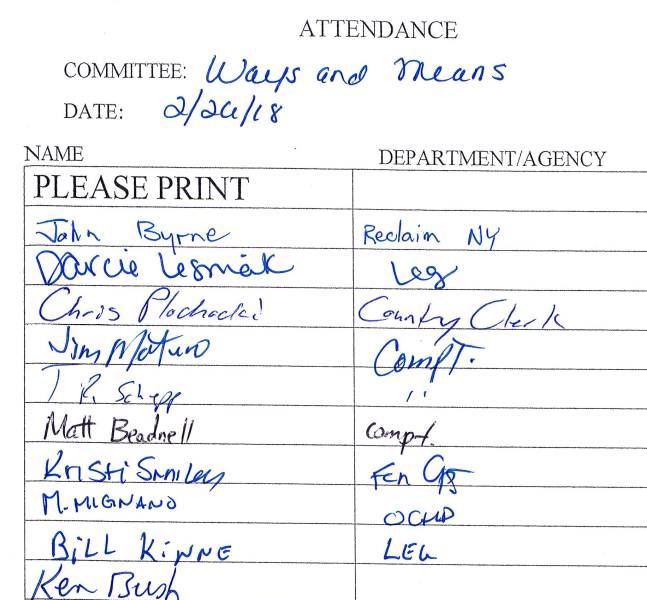
|































































